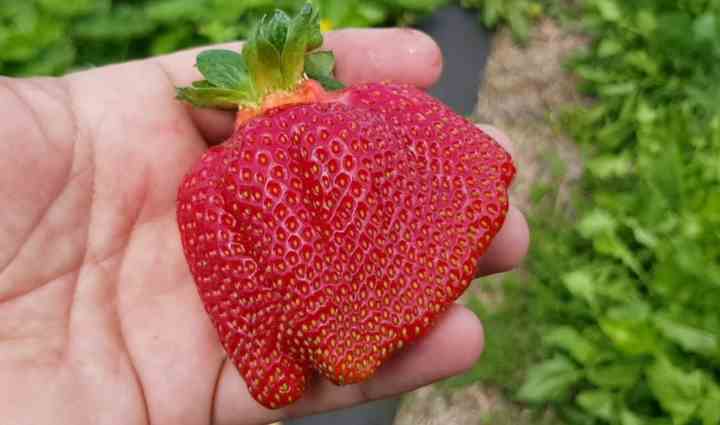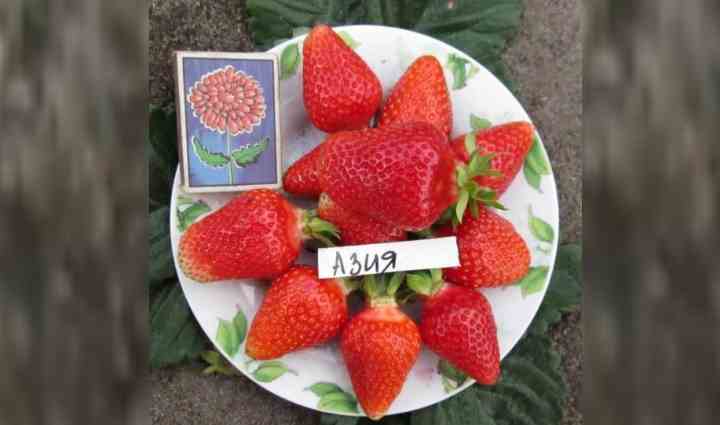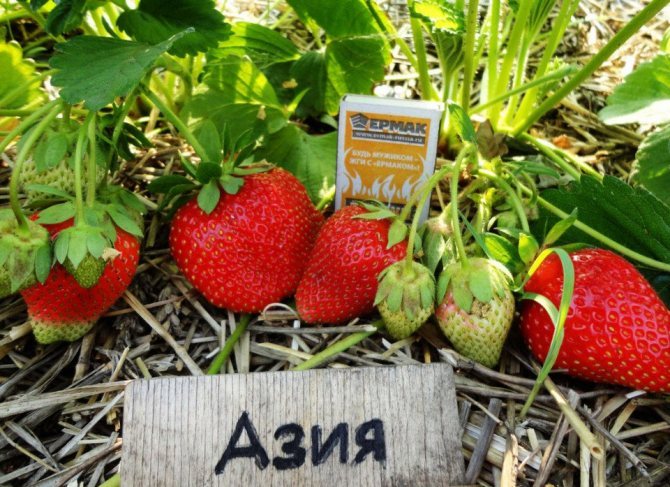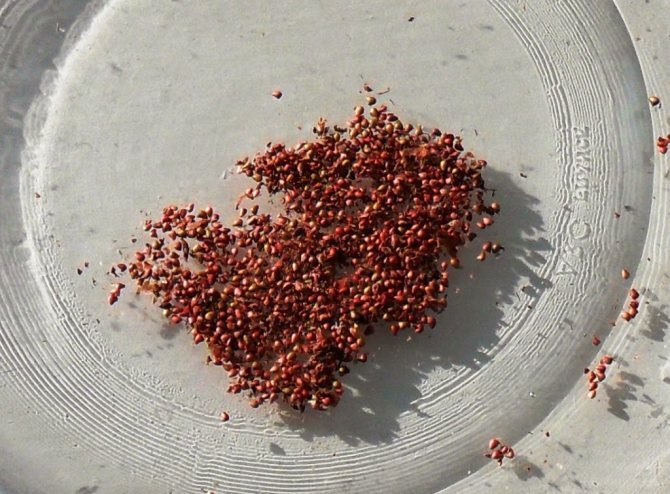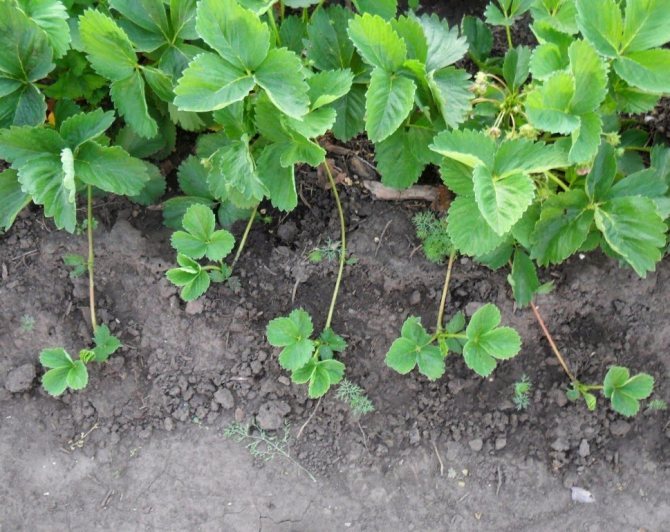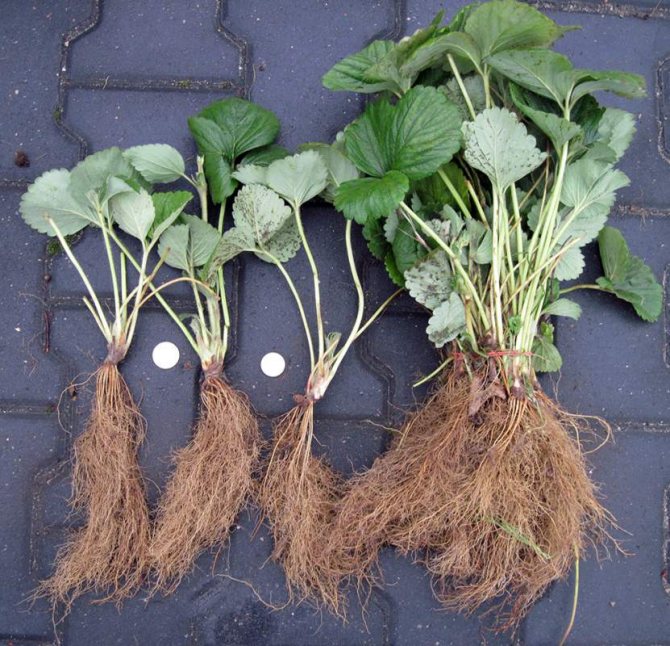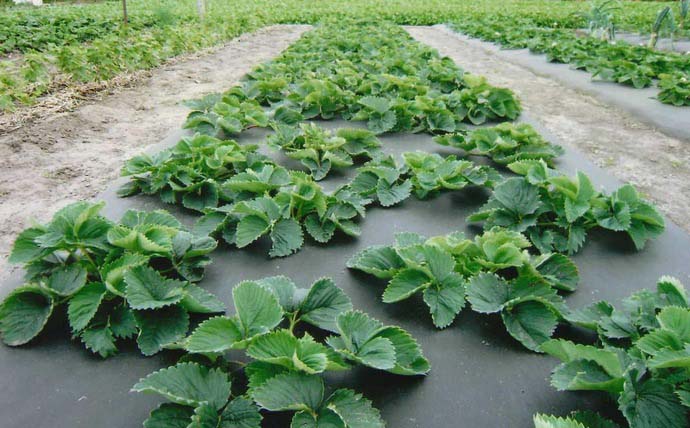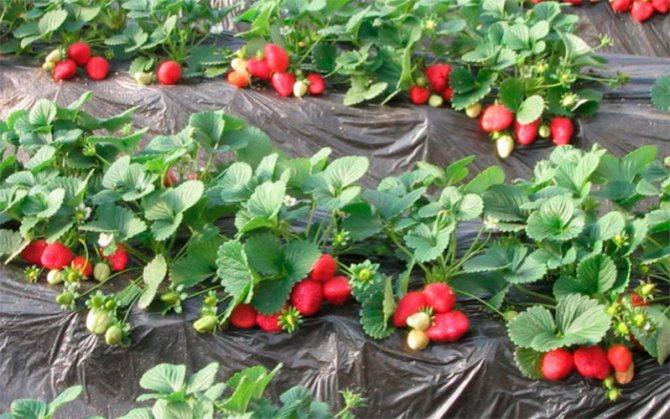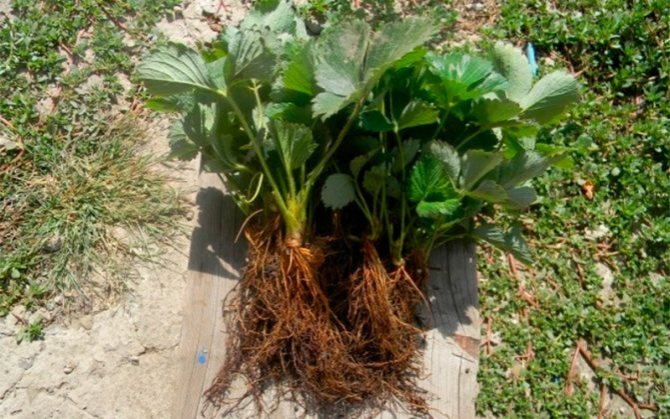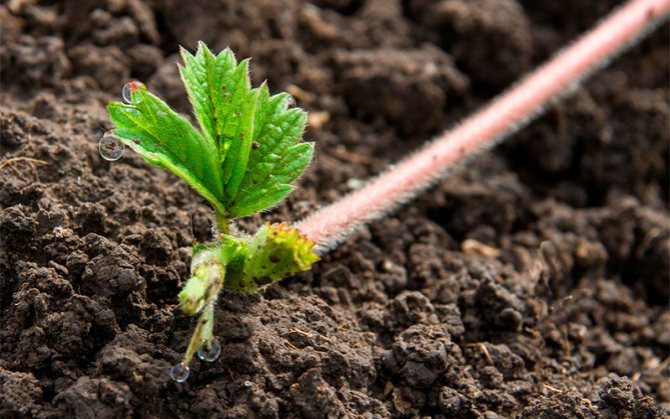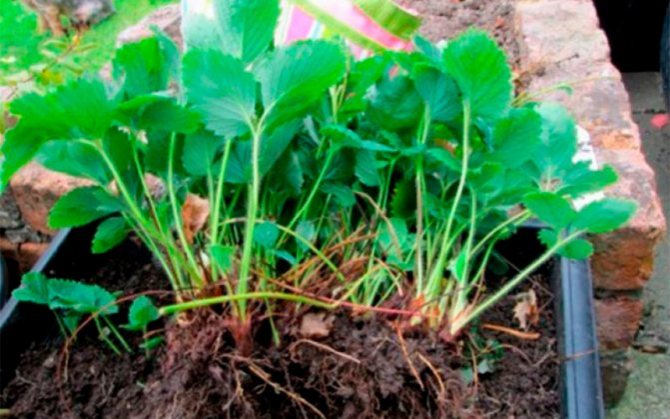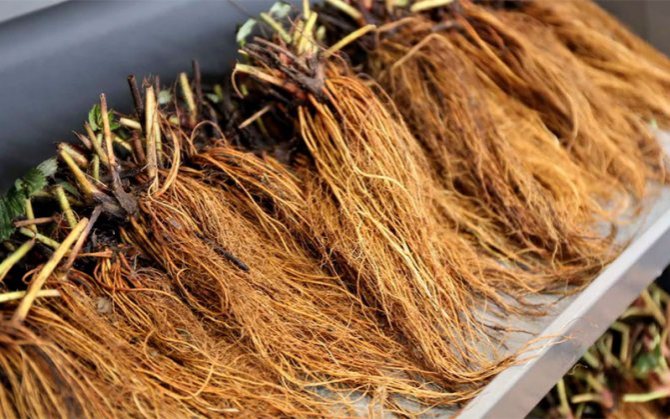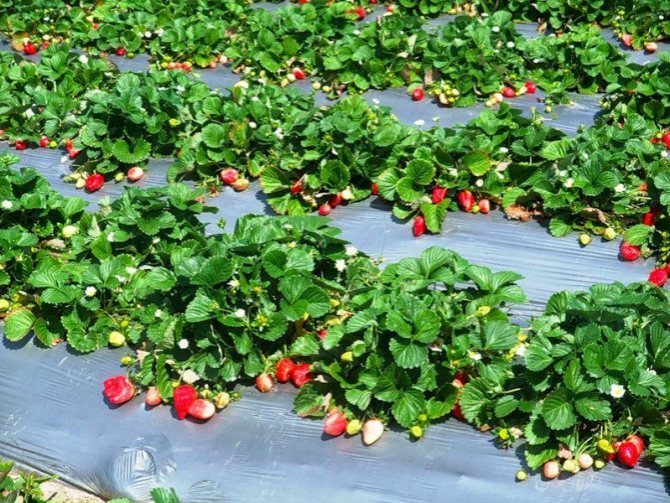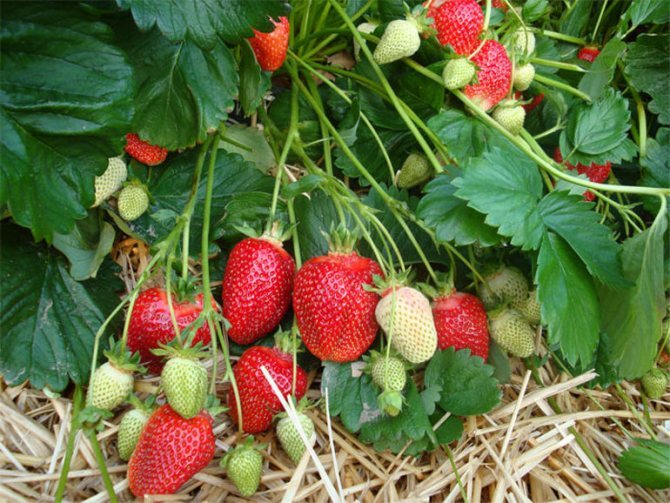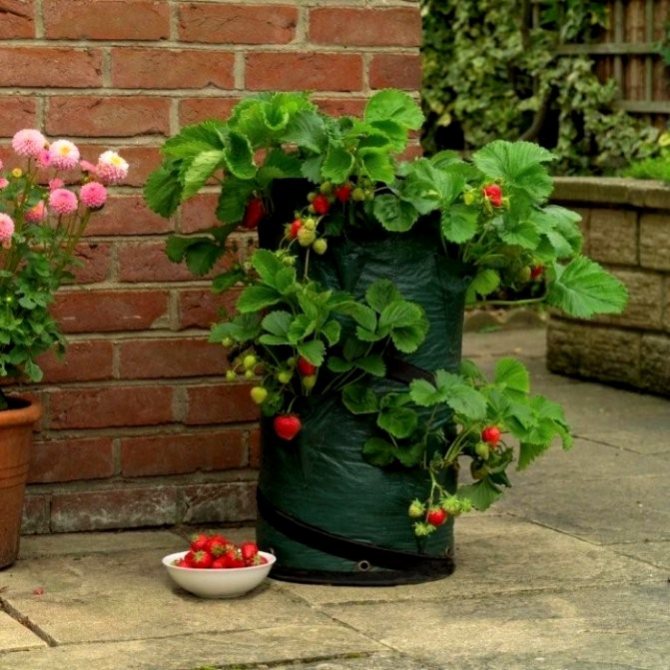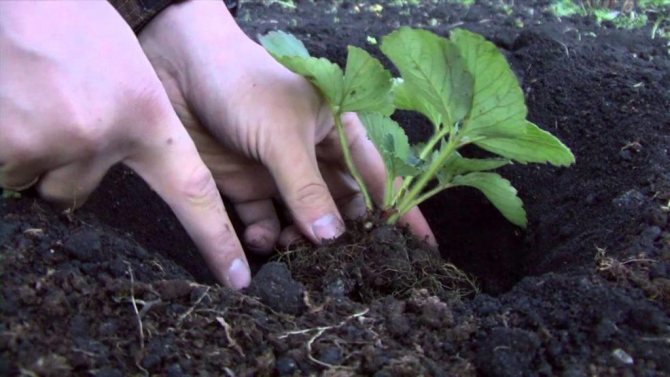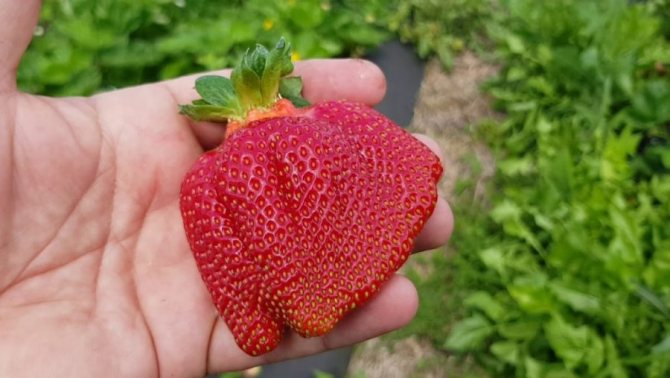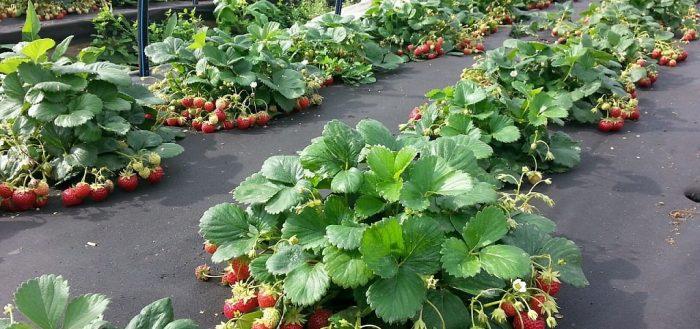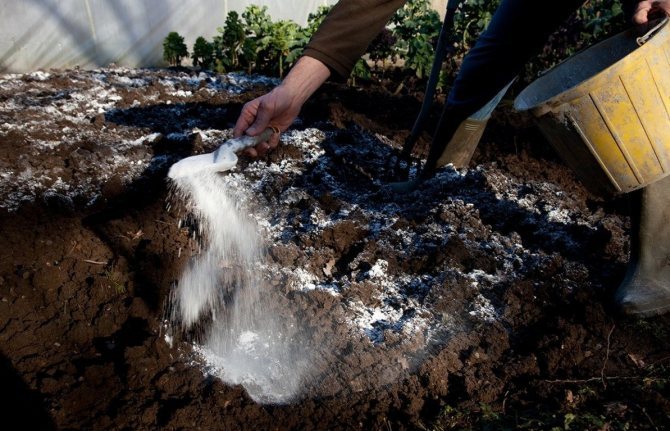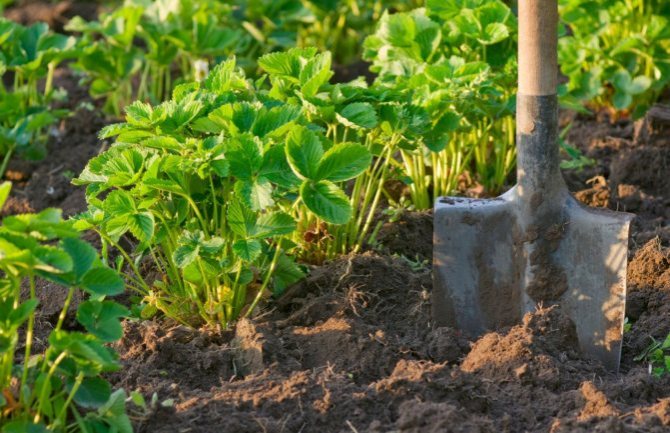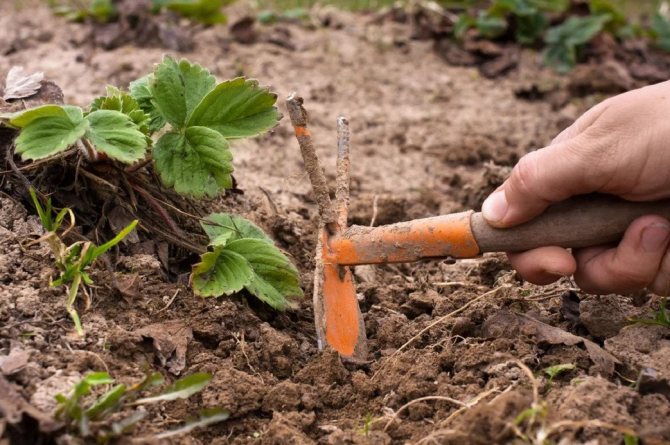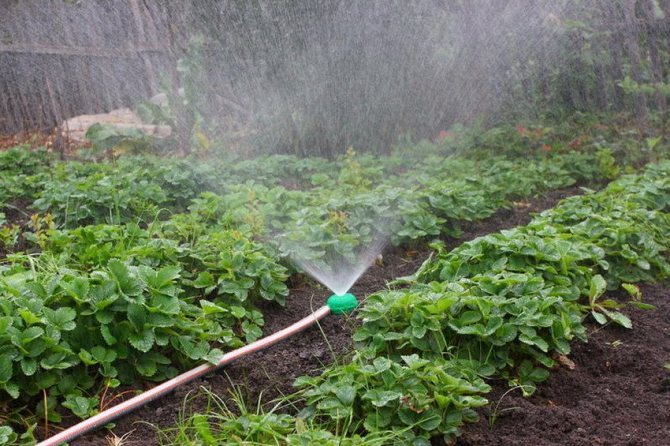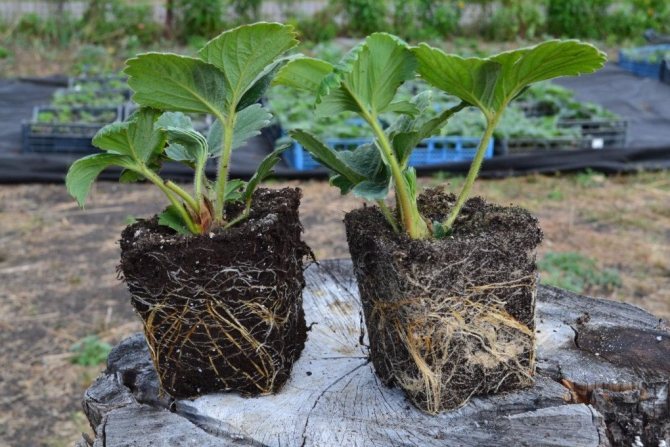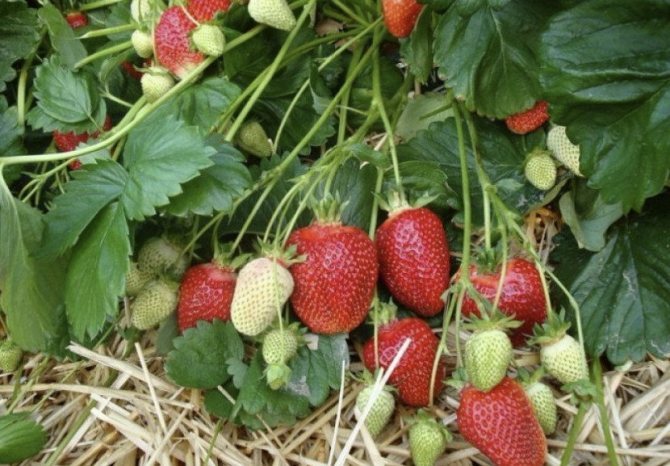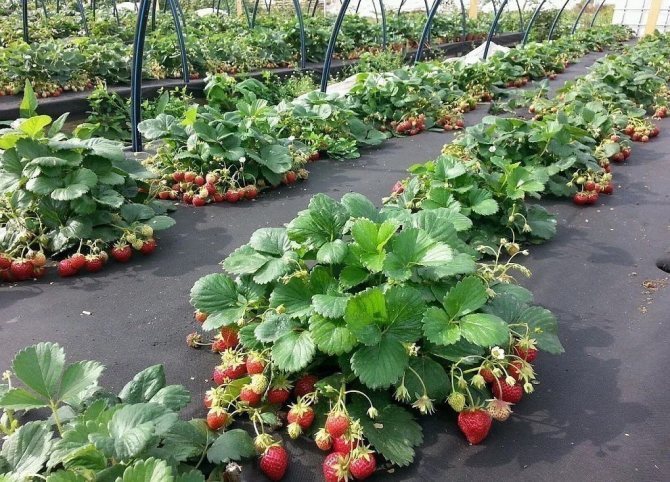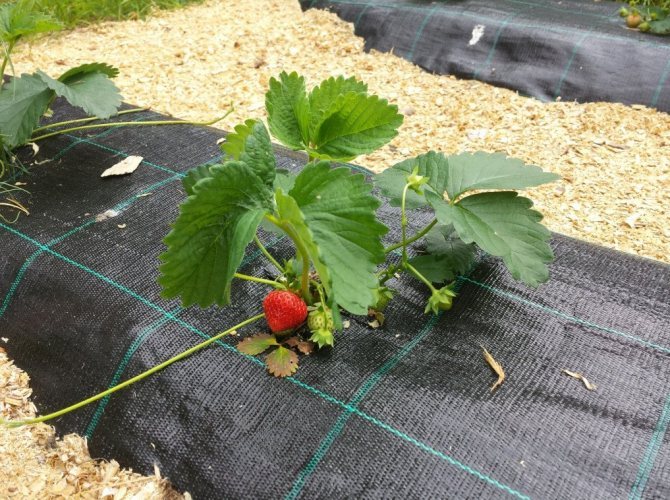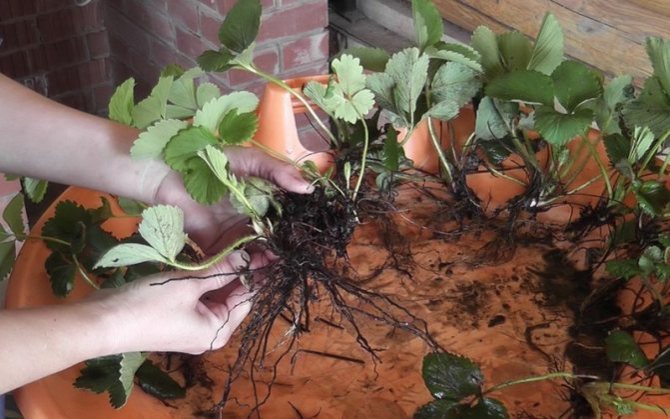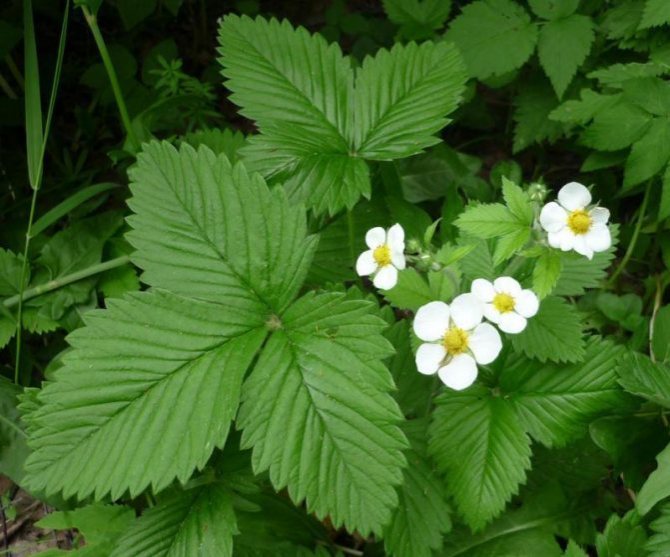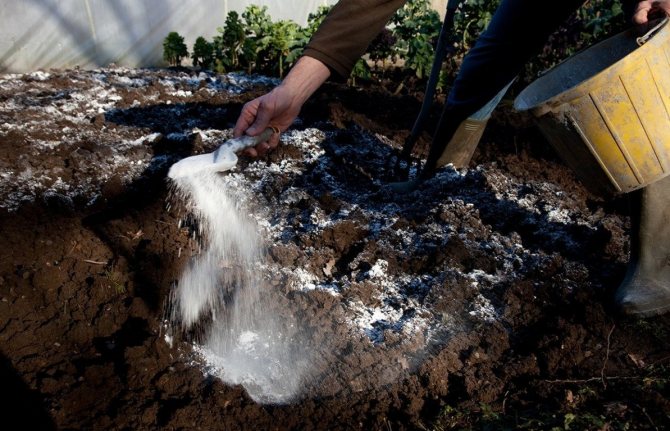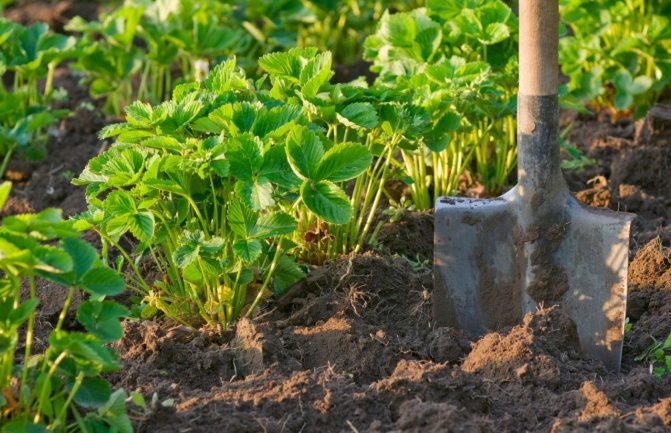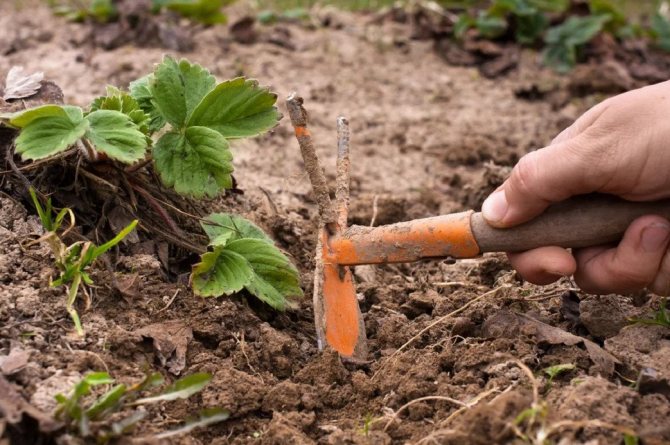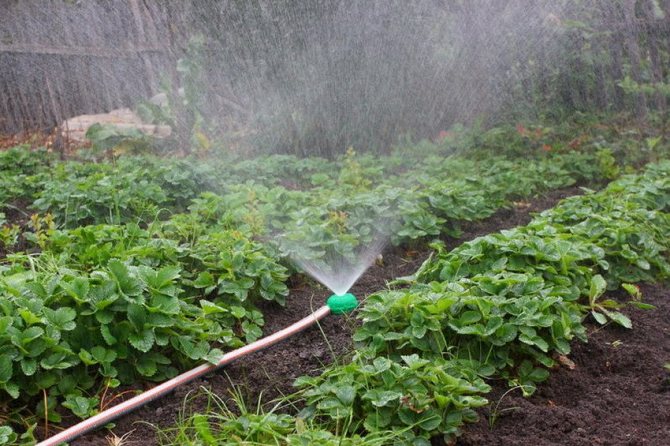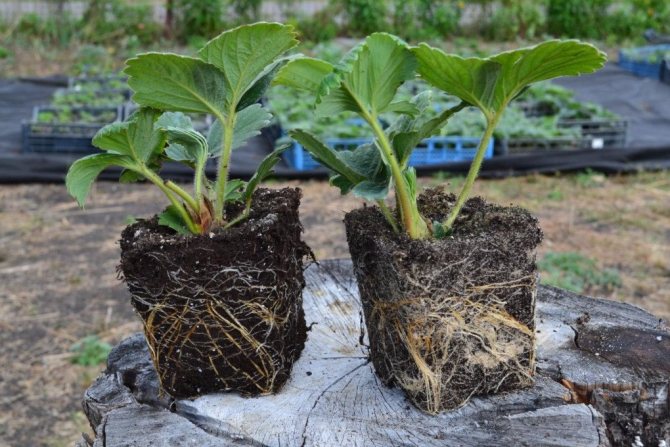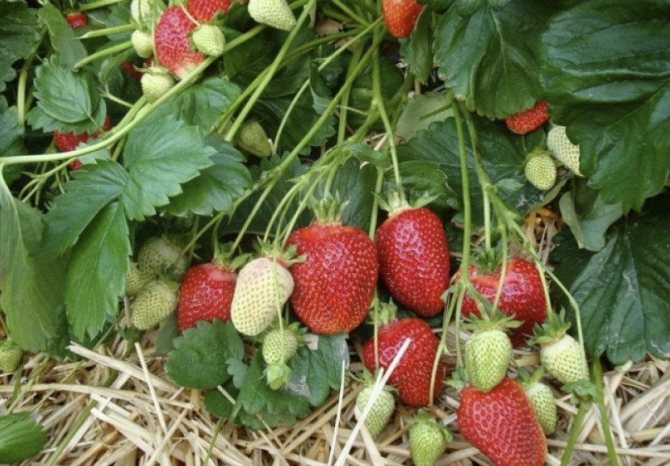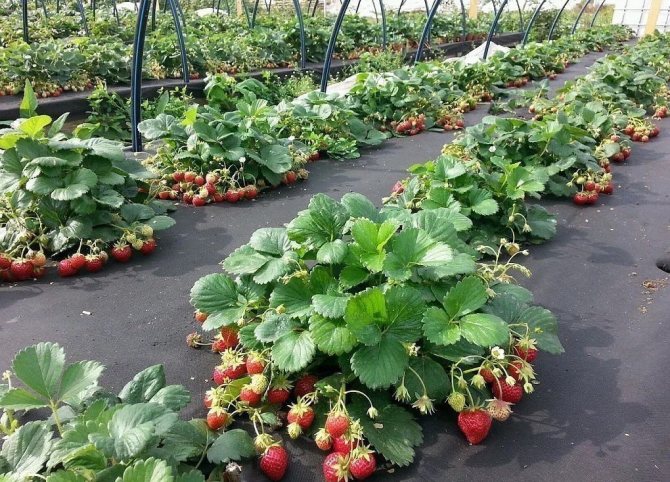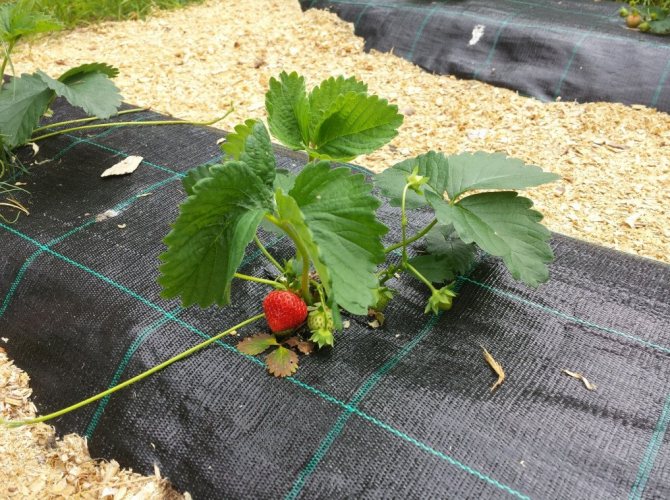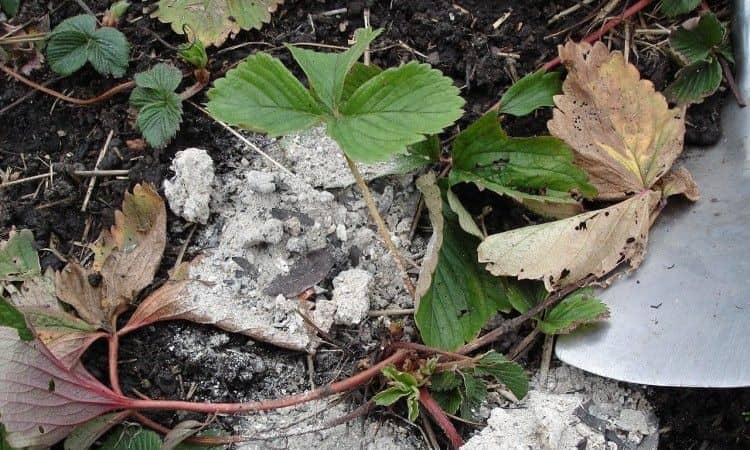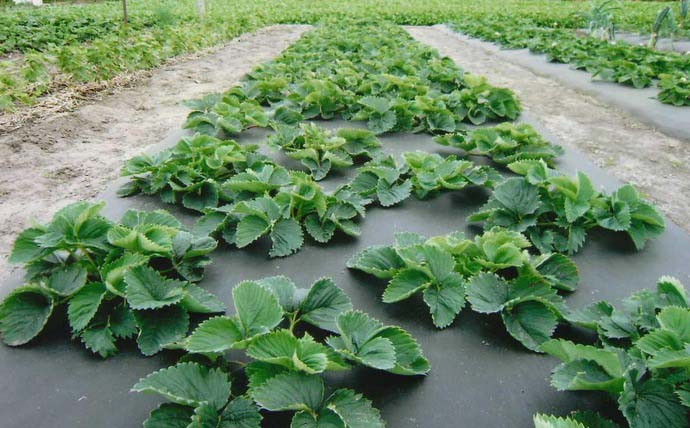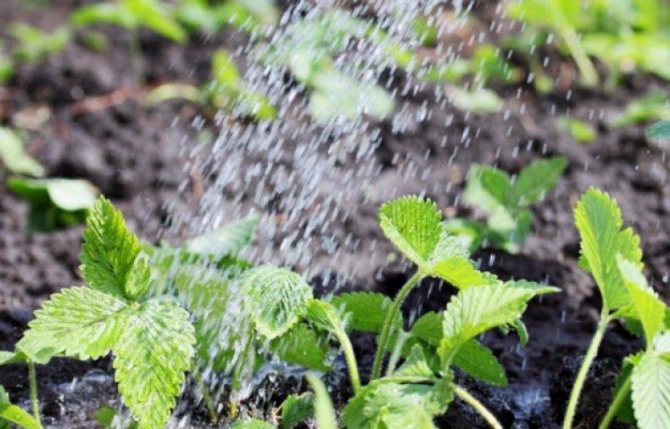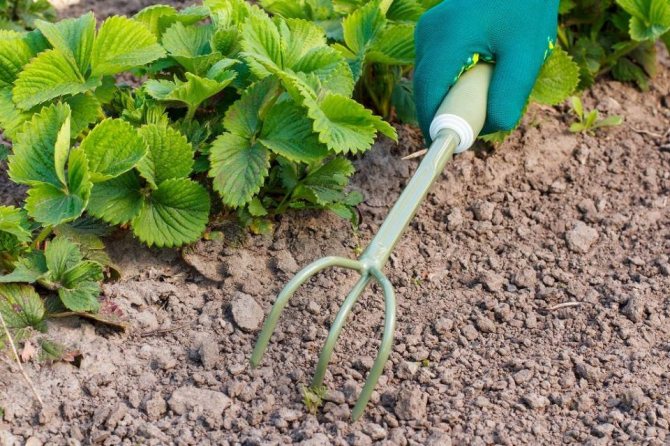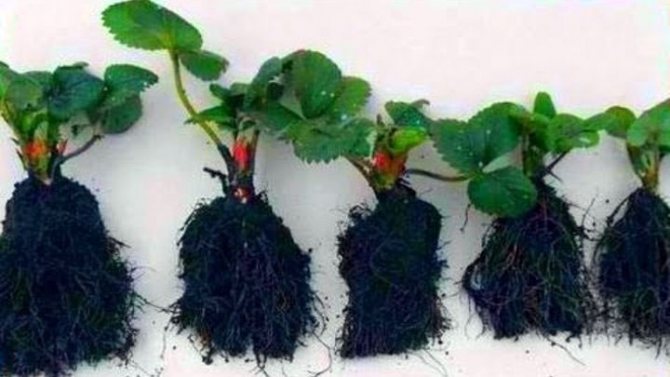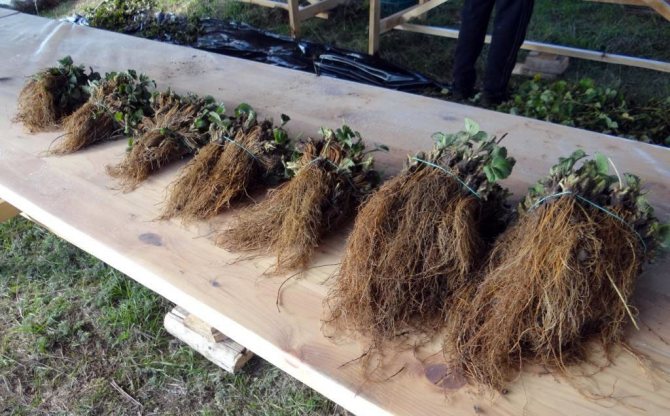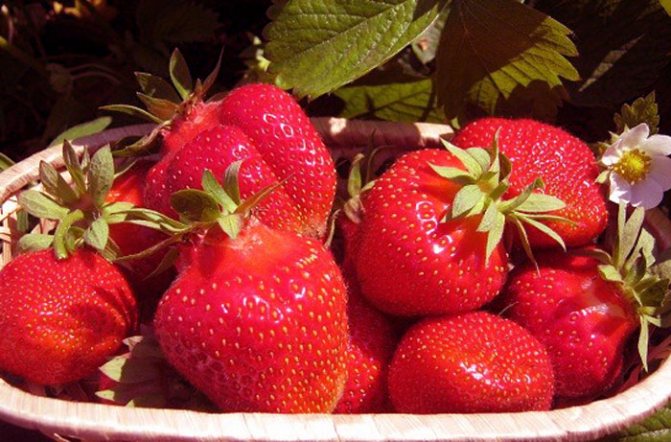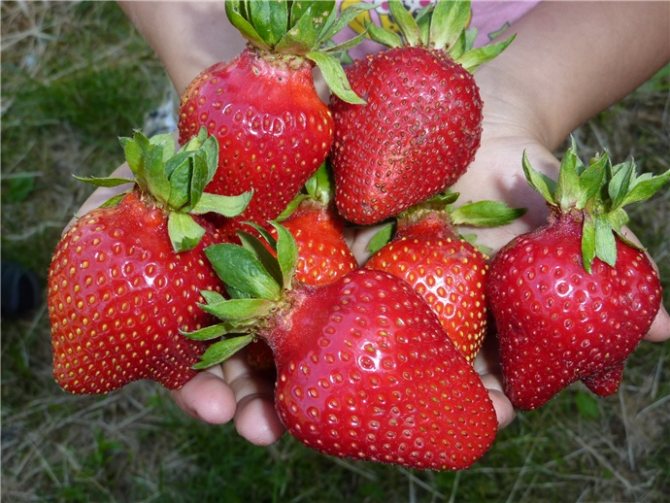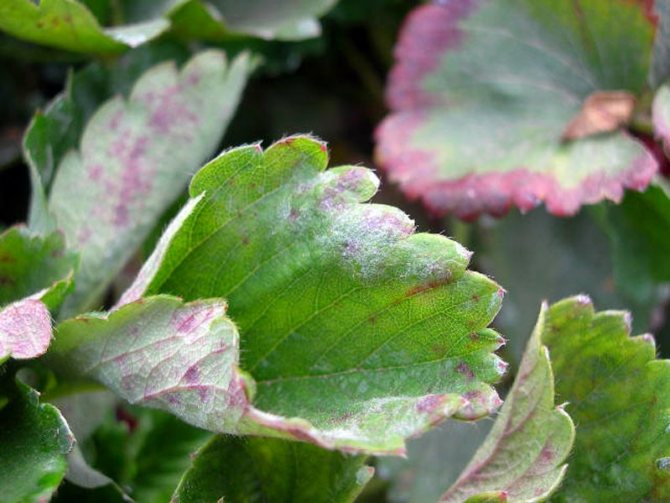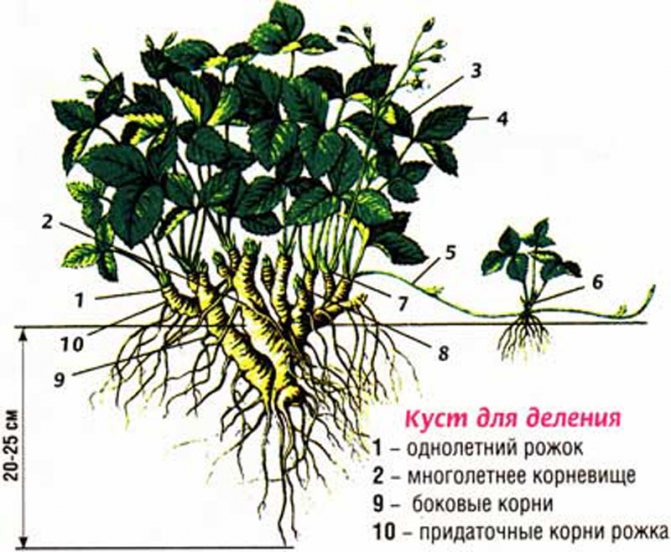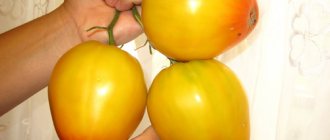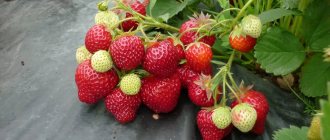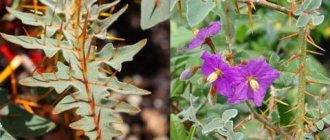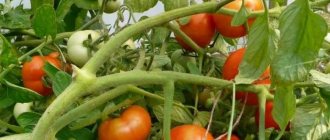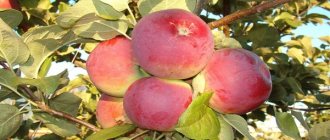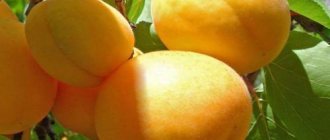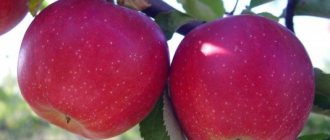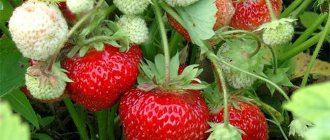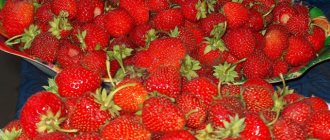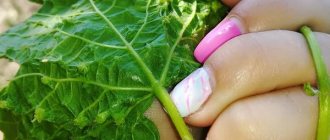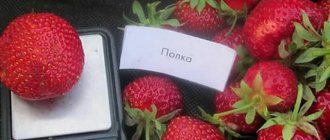Strawberry "Asia" is an industrial variety of large and juicy berries, first bred in Italy in 2005. He took root well in Russian garden plots. Loved by many farmers for its high quality and excellent transportability. It is often used for business purposes: large and very tasty berries are sold in large quantities in the markets. But also recommended for amateur gardening. The characteristics of the berry are described below.
Dear Readers! For you, we have created communities in social networks, in which useful articles and interesting ideas are published several times a day! Subscribe and receive useful content in a convenient format!
Description of the strawberry variety Asia
Strawberry Asia is a variety of medium early ripening and extended fruiting. It belongs to the industrial type. The yield is very high. Frost resistance and drought resistance are average. It is not recommended to test the capabilities of the variety; in severe frosts, you need to throw more snow on it, and in case of droughts, ensure timely watering and a weak shade from the sun.
The bushes are quite large and wide. The number of leaves is moderate. The leaves of the variety are bright green, shiny, slightly wrinkled. Each bush lets out tendrils in small numbers, but they are quite enough for reproduction. The root system is very well developed. Peduncles are always high, rise above the leaves.
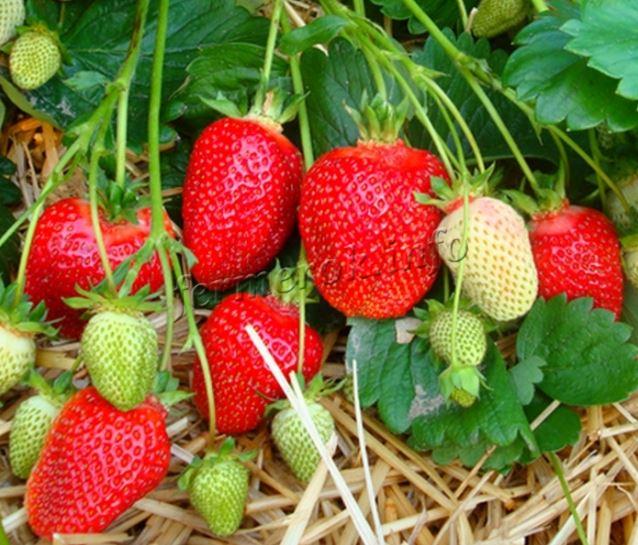
Photo of strawberry varieties Asia
The berries are large, each weighing 30-40 grams. It is worth noting that the berries of the first wave are the largest and sometimes reach a weight of 60-80 g! Elongated cone shape. The Asia strawberry variety has a bright red, glossy color. Seeds are small, yellow, "scattered" over the surface of the berry. The pulp is dark pink, like the rind, dense. The taste is juicy, sweet, the tasting score is 4.6 points out of 5 possible. The berries have a strong, strawberry flavor.
Fruit characteristics
What do they love strawberries for the most? Of course, for her berries. And in this respect, the Asia variety compares favorably with many others in the shape and size of strawberries. On average, the size of berries can vary from 25 to 40 g, but truly gigantic specimens weighing up to 100 grams are quite common. And in general, the berries are rather large, and most importantly, with age, they practically do not crush them, like in many other varieties.
The shape of the berries is also often unusual. As a rule, they resemble a truncated, slightly flattened cone, sometimes with two tops.
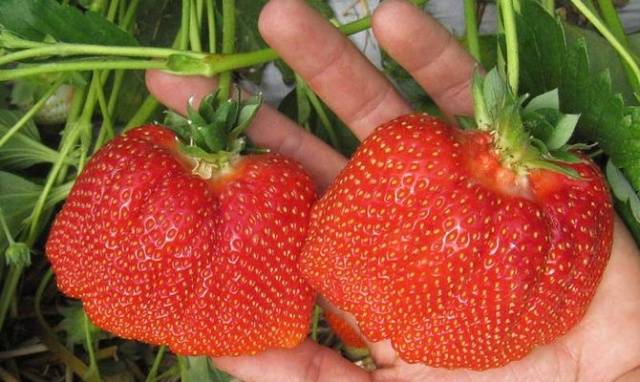

The color of the berries is rich, bright red, with a glossy finish. The pulp has the same color, but a more delicate shade. Internal voids are usually not observed, the density is moderate.
The flavor characteristics of the Asia variety are excellent.
Attention! Strawberries of this variety contain a lot of sugar, so the berry can be eaten straight from the bush, enjoying its pronounced strawberry aroma.
Strawberry Asia belongs to the versatile varieties due to its wonderful taste. It is suitable both for fresh consumption and for freezing, as well as for preparing an infinite number of preparations for the winter: jam, jam, compote and other yummy foods.
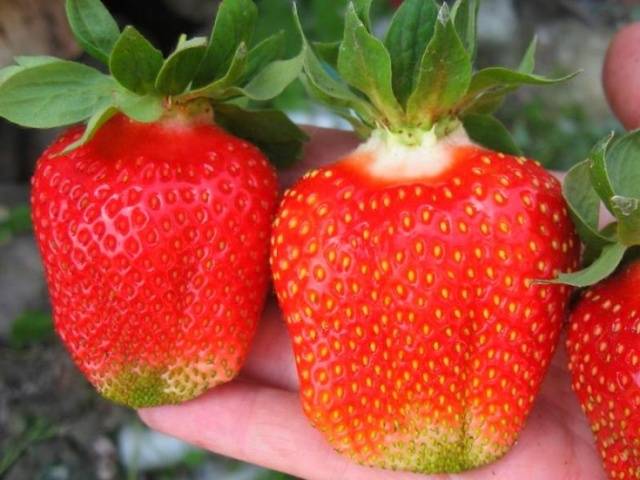

The berries are easily detached from the stalk. Strawberries of the Asia variety are quite suitable for long-term storage at low temperatures, as well as for transportation over long distances.In addition, the berries are able to attract buyers with their appearance. From the foregoing, it follows that the Asia variety may well be grown for sale and even used on an industrial scale.
In this video, you can see the berries and bushes of strawberries Asia from all angles:
Gardeners reviews
- The Asia variety is very productive. On one bush, it ripens up to 1.5 kg. berries. They are delicious and great for preparing a variety of culinary dishes. The bushes have many flowers and tolerate heat well. Plants of the Asia variety love feeding with chicken droppings and watering once a week. The variety is good especially for beginner gardeners. Recommend.
- I have always liked this particular variety. The bushes are very beautiful, winter well and begin to grow quickly with the arrival of spring. Drought tolerant. The berries are beautiful in appearance and delicious. From 1 square meter, up to 4-5 kg are harvested. excellent berries. The variety loves light soils and feeding. The pulp is firm and sweet. The best strawberry I know. Grow Asia variety - you will not regret it.
- The variety is fruitful and unpretentious in cultivation. The berries are large with a beautiful color and an unusual shape. The berries are fleshy and can be transported well. The variety is easily propagated by seedlings, as each bush can produce up to 20 first-class whiskers. I collect 2 kg from a bush. berries. Plants love weeding and watering. I'm happy with the variety.
- This is my first strawberry variety. I haven’t dealt with strawberries before. But thanks to the fact that the variety does not require any special care, everything worked out for me. Already in the third year I have been collecting 2 kg. fruits from the bush. The berries are aromatic and very sweet. The bushes tolerate drought well and have many peduncles. Excellent variety.
Testimonials
Find out what experienced farmers have to say about growing strawberries in Asia.
- Anatoly, 58 years old, Tambov: “I have been growing Asia strawberries for several years now, and I am very pleased with this variety. Strawberries give high yields, the taste of the berries is wonderful, however, and careful care is required. But if you follow a few simple rules for watering and weeding, as well as top dressing, you can get a stable one and a half kilograms of berries from a bush as a result. Asia is going through winter well in the open field, I cover it with a film. "
- Pavel, 47 years old, Rostov: “I have a farm: we grow fruit crops and berries, in particular, strawberries. There are several varieties, but one of the most beloved and fruitful is Asia. The variety pleases with its stable fruiting, excellent taste of berries and their good keeping quality. I must say that the variety is not resistant to rot and powdery mildew, however, timely spraying and proper planting can prevent this problem. In general, I am satisfied - I advise the variety: although it is a southern variety, it grows well in our latitudes
This information will help you understand how to care for the Elvira variety.
What are the advantages of strawberry Asia?
Check out these articles as well
- Zucchini variety Gribovsky 37
- Diseases of chickens and their treatment
- Root celery
- Cabbage variety Nadezhda
Strawberries Asia has many disadvantages, and yet the seedlings and seeds of this variety are eagerly snapped up by gardeners around the world. This is due only to the mass of positive qualities.
- The yield is high, 1-1.2 kg of strawberries can be harvested from one bush per season.
- The taste of the berries is excellent. Even after processing, they do not lose their taste and pleasant, strawberry aroma.
- The berries have excellent commercial qualities, they can be successfully transported over long distances.
- Refers to varieties of short daylight hours.
- Unlike many large-fruited strawberry varieties, Asia does not form voids in berries.
- The plant quickly adapts to any climatic conditions. Initially, the variety was intended exclusively for the hot Italian climate, but now it is successfully grown in the middle regions of Ukraine and Russia.
- Strawberry Asia has a high resistance to diseases of the root system and some fungal diseases.
- Fruiting of the bush lasts 4 years, then the yield drops rapidly and it is recommended to replace the bush with young ones.
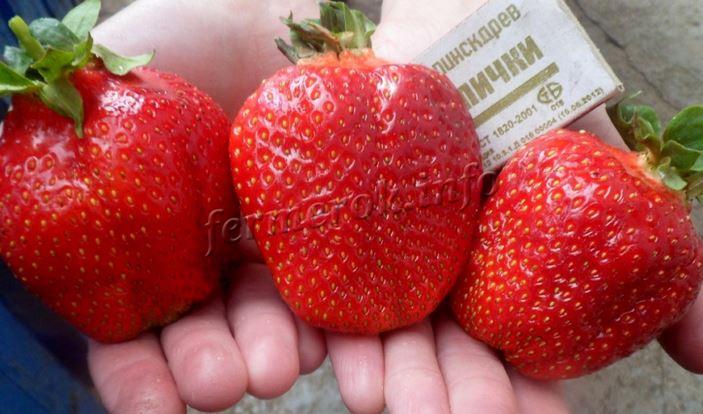

Photo of strawberries asia
Harvesting and storage
The first berries of this variety can be harvested already in the 1st decade of June, if the strawberry grows in the central region. In the southern regions, the harvest ripens by the last days of May. The berries are picked in several waves for almost a whole month.
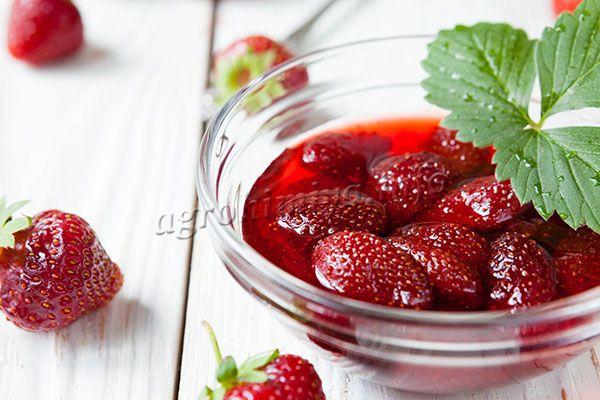

Strawberries Asia is suitable for fresh consumption as well as for processing
After picking from the garden, the berries can be stored in the refrigerator for up to a week. The variety is universal. Berries are suitable for fresh consumption, as well as for processing (canning, freezing, drying). After processing, they retain a pleasant aroma and taste.
How to plant
Consider the features of planting strawberries.
A place
It is important to choose a site for this variety that is protected from winds and drafts: the thermophilic culture does not like these atmospheric phenomena. It is best to place the bed on a flat place or on a slope on the south side, where there is a lot of sun and heat. It is important that the garden bed is well lit most of the day and also well watered.
Keep in mind that steep slopes, as well as lowlands where there is little sun and a lot of water, Asia strawberries are not suitable. In this case, good harvests cannot be expected: the bushes will begin to ache, and may not even begin to bear fruit, or the berries will be small.
We recommend that you familiarize yourself with the description of the Kama variety in this material.
Priming
You need to know that clayey, sandy or high carbonate soils for strawberries Asia are not suitable: bushes planted in such soil can get chlorosis. Strawberries will thrive best in light, loose, air-filled soil.
It is important that the soil is slightly moistened all the time, it must not be allowed to dry out. In this case, the berries may lose their juiciness.
Care after landing
Features of caring for young strawberry bushes:
- Top dressing. Young seedlings do not need feeding during the first season - enough fertilizers have been applied to the soil before planting.
- Watering. The planted strawberries are watered as needed - the soil should always be slightly moistened, but not flooded.
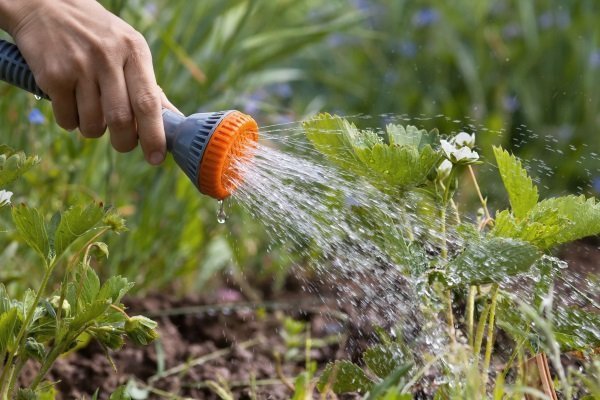

Features of planting varieties
We recommend reading our other articles
- How to grow strawberries from seeds
- Dobrynya garlic variety
- Open field cucumber varieties
- Ear mite in rabbits - signs and treatment
Growing strawberries in Asia is a laborious process. Any wrong action can significantly reduce the yield of the plant. It is best to propagate the variety with antennae. After rooting, small rosettes are seated at their own discretion. This breeding method is the most effective, fast and simple. Seeds should be purchased only if there is nowhere to get seedlings.
Strawberries of the Asia variety are grown in open and closed ground. In greenhouses, it takes root faster and better, gives large yields, so this method is preferable. A landing site should be chosen well-lit, moderately ventilated, without direct draft. The variety is picky about soils. It is best to grow strawberries of this variety on nutritious, not very heavy soil with neutral acidity.
Planting time should be postponed until spring. Some strawberry varieties can be planted in the fall, but not in Asia. This variety loves warmth and simply will not take root in the fall, when the humidity is almost always high and very cool. But planting strawberries in spring makes it possible to take root with bushes, take root well over the summer.
It is necessary to plant seedlings so that there is 30-40 cm of free space between individual bushes, the outlet is never buried. The row spacing is made about 50-100 cm.The first fruiting of the strawberry variety Asia gives a year after transplanting, if everything was done correctly.
Landing procedure
Usually strawberry bushes are planted in the ground in a checkerboard pattern. This method of growing provides each bush with the optimal amount of free space around.
You may also be interested in the description of the Clery variety.
Inspect all the bushes carefully before planting. If there are specimens with a bent root, they cannot be planted. The roots of the plant must be straightened out.
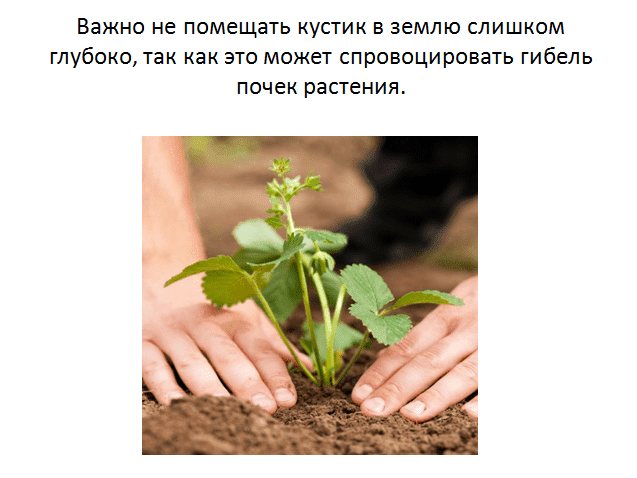

Before planting, thoroughly moisten the soil, and then mix, achieving a thick sour cream without coarse fractions and lumps. Strawberries Asia are planted in such a soft and nutritious soil. The bushes do not take root immediately - this becomes clear within the next 12 days after planting.
You can find a photo of the Dukat variety at the suggested link.
Diseases and pests
So that young seedlings do not catch viruses, fungal diseases, develop correctly and give a good harvest, the following preventive measures are taken:
- treat the soil before the first planting with Fitosporin, Karbofos, copper oxide;
- remove weeds or cover the soil with black garden film;
- strengthen the immune system with fertilizers and stimulating drugs, for example, Zircon or Immunocytofit.
Growing Asia, according to reviews and photos, brings good results from the first year of planting. In regions with cool summers, it is advisable to choose the method of planting in greenhouses. Photos of Italian strawberries grown by summer residents in a special selection.
Further care for strawberry plantings of the Asia variety
In the spring, after the snow melts, work begins on the strawberry plantation: they remove all the old mulch, plant residues, remove dry foliage and dead shoots.
It is also important to observe the irrigation regime - if the bushes lack moisture, then small fruits with a large number of voids in the pulp will form on them. Water this strawberry as the soil dries up. Watering is carried out with filtered warm water in the early morning or evening strictly at the root. Water droplets should not fall on foliage.
Strawberry ASIA. Berry taste - video
Ideally, it is advisable to equip drip irrigation on a strawberry plantation.
In hot dry weather, the amount of watering is increased.
After watering, it is necessary to break up the resulting dry crust on the ground so that moisture and oxygen can calmly flow to the roots. Weeds must be removed at the same time.
Often, gardeners stretch black polyethylene on strawberry beds, in which they make holes for strawberry bushes. When it makes it possible to take care of the strawberries more easily, and the moisture evaporates more slowly. But we must remember that this method is not suitable for everyone; you must first check it in a small area of your garden.
Feeding strawberries
Fertilizers should be applied to the strawberry beds in Asia according to the following scheme:
- at the beginning of spring, fertilizing should be carried out with fertilizers containing nitrogen - 20 g of urea is diluted in a bucket of water and 500 ml of such a solution is added under each bush;
- during the same period, you can "pamper" strawberries with ash, superphosphate, potassium salt or other fertilizers containing phosphorus and potassium;
- in September, a mullein solution is added under the strawberry bushes, to which wood ash is added.
Photo of feeding strawberries
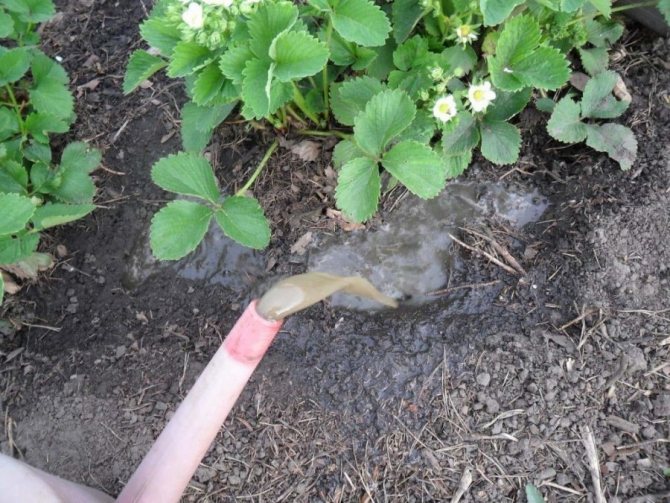

Important!
From the beginning of budding to the end of fruiting, you cannot feed Asia strawberries!
Preparing for winter
Since the variety is not highly resistant to frost, in regions with harsh winters, the strawberry plantation must be covered for the winter. This procedure is carried out after a negative air temperature is established in the region. Above the beds, metal arcs are installed, on which any non-woven fabric is stretched, but you can cover the bushes with spruce branches or spunbond.
How to care for Asia strawberries?
Care can be a significant investment, but the effort pays off when the Asia strawberry begins to bear fruit.
- Watering is necessary regularly, so it is recommended to equip a drip system. It is very easy to deal with it, watering will be uniform, in moderation, which is what strawberries need.
- If a strong wind or draft is observed on the site, it is worthwhile to make artificial protection from 2 sides: plant bushes, put a damper, a fence.
- Top dressing is applied several times per season. Nitrogen mixtures are necessary in the spring, after fruiting, you can feed strawberries with fertilizers with a high content of potassium and boron. And closer to autumn, they introduce superphosphate in granules.
- If the gardener does not need to propagate the Asia strawberry variety, then all mustaches are removed. They only draw juices from the bushes and reduce the yield. Therefore, they are cut off, not allowing them to develop. If you need to get seedlings for breeding the variety, you should leave a few bushes under the mustache. Peduncles are removed from them, and the mustache is allowed to develop freely.
- The soil around the bushes must be loosened every 3 days so that it does not take on a dense crust. Separate bushes are spud up as needed. But it is important that no earth gets into the inside of the socket!
- About once or twice a year, it is necessary to treat plants with complex preparations for diseases and pests. It is recommended to use specialized biological products (Vaxiplant SL, Lepidotsid, etc.) or folk substances. Processing is carried out before flowering or after fruiting, closer to autumn.
- For the winter, the aisles of strawberries must be mulched 15-20 cm with straw. The bushes are also covered with straw to protect them from frost. You can cover the bed with white agrofibre on top of the straw. In winter, so that the strawberries do not freeze, more snow is thrown over it.
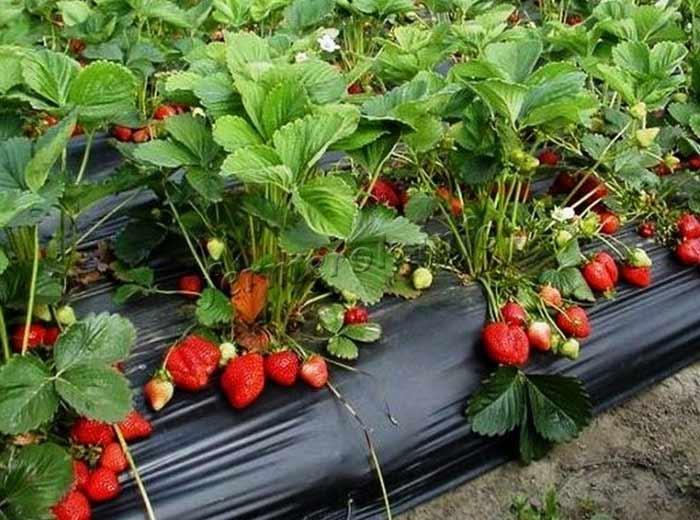

Growing varieties of strawberries Asia
Pests and the fight against them
The Asia variety is most often affected by mites - strawberry and spiderweb. Also, strawberry nematodes and weevils can inflict the harvest.
Common pests of the Asia variety and the fight against them:
| Pests | Harm done | How to fight? |
| Strawberry nematoda | Small worms - up to 1 mm long, parasitize the plant, leading to metabolic disorders and the almost complete disappearance of berries. The leaves are deformed, the flowers become dirty green, the fruits are small, ugly. | Before landing - a contrast shower (48 ° С - for 10 minutes, cold - for 15 minutes). |
| Weevil | The larvae eat the pedicels. | Processing at the stage of budding Inta-Vir. |
| Strawberry mite | They suck the juices from the leaves - they become wrinkled and oily. | Treatment with colloidal sulfur or Karbofos - early spring. 2 weeks before flowering - Neoron. |
The main preventive measure to prevent pest damage to strawberries is to observe crop rotation. All diseased bushes must be dug up and destroyed.
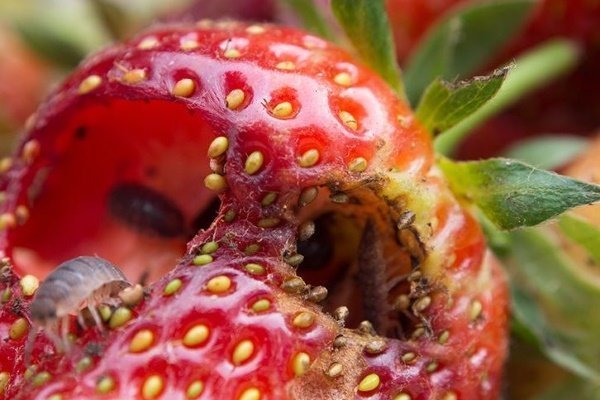

Strawberries or strawberries?
Very often, amateur gardeners mistakenly call a berry growing in a forest - strawberry, and one grown on their site - strawberry. Let's take a look at what are the differences between these plants.
- Strawberry bushes are heterosexual (that is, on each bush there are either exclusively stamens or exclusively pistils). The low productivity of strawberries is due to the need for pollinators.
- Strawberry berries are small, rich scarlet, very aromatic.
- Garden strawberry plants have both stamens and pistils at the same time. Accordingly, strawberries do not need pollinators and always pleases with an excellent harvest.
- The berries of garden strawberries are large enough, sweet, with a slight sourness.
- Strawberries are easily separated from the receptacle, strawberries - with difficulty.
Photo gallery: the differences between strawberries and strawberries
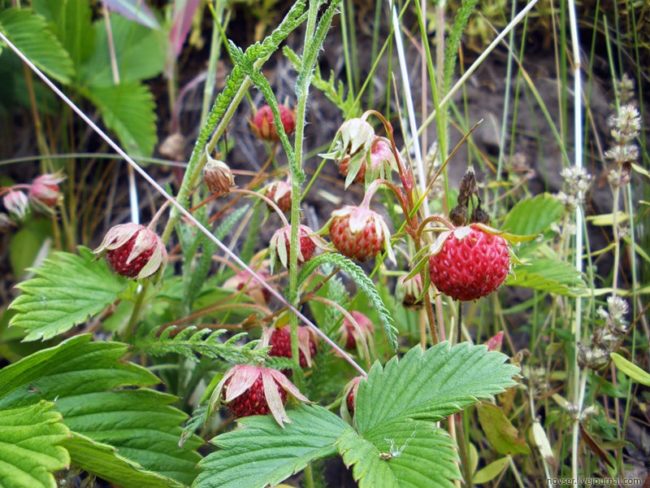

The main difference between strawberries is small berries that rise above the leaves.
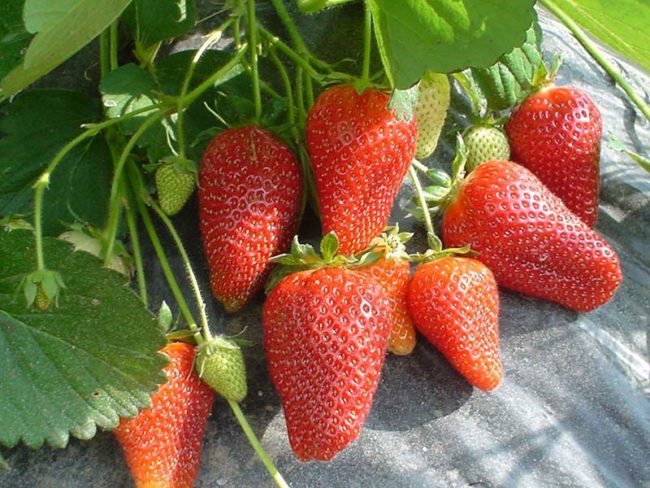

Strawberries do not need pollinators, so they always please with excellent yields
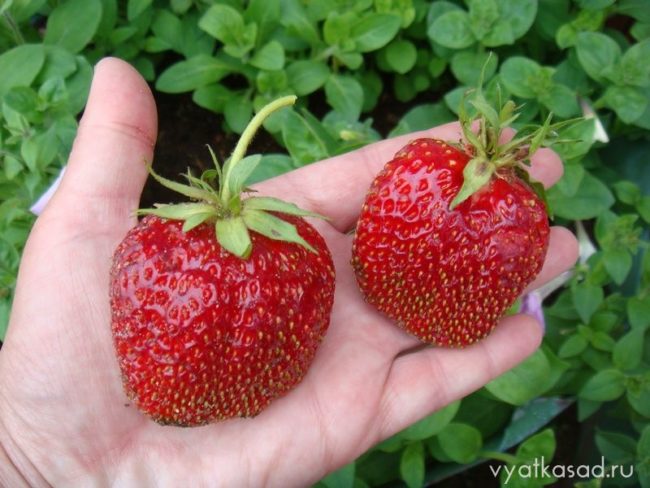

The strawberries are quite large
Differences between strawberries and garden strawberries
Garden strawberries are often, by mistake or habit, called strawberries. But the culture that is now being grown in our gardens is strawberries. She has large berries, short peduncles, fruits are easily separated from sepals. Strawberries were also cultivated until the beginning of the 20th century, but this berry is less susceptible to selection and large-fruited has not yet been bred.
Photo gallery: strawberries and garden strawberries
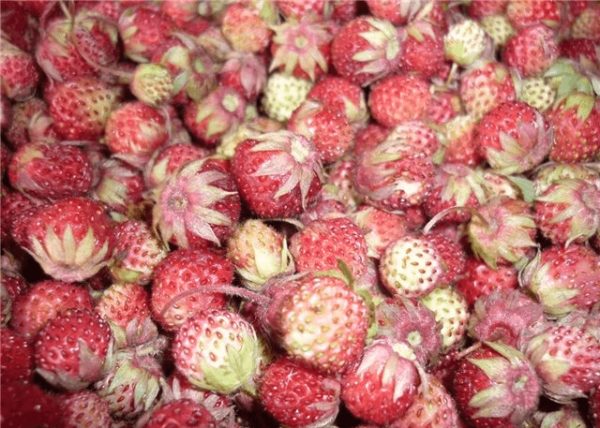

Strawberries, even when ripe, are not completely colored
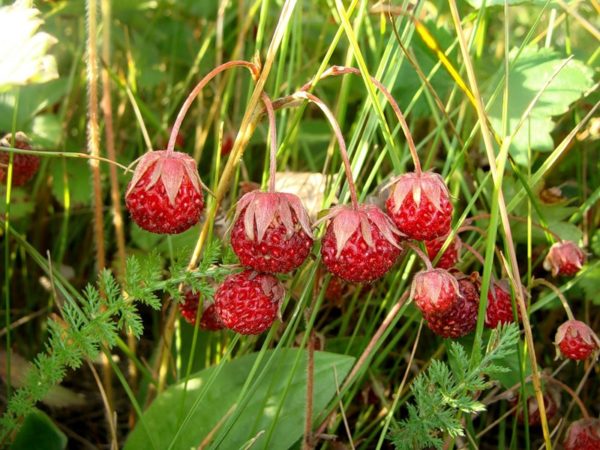

Strawberry flower stalks are high, berries are small
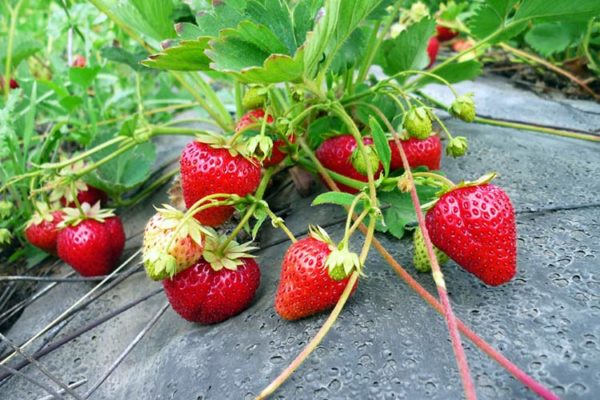

Garden strawberries are much larger than strawberries
Wintering culture
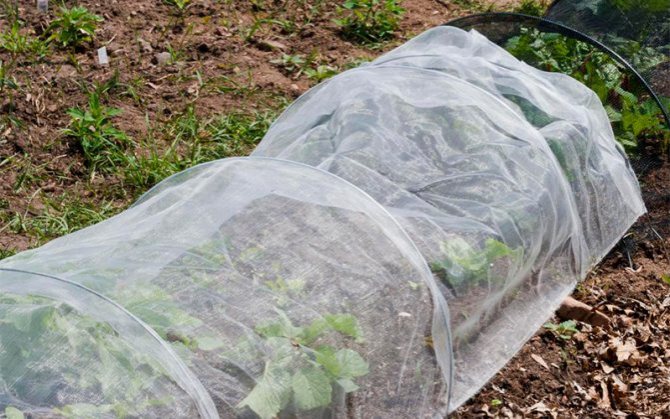

The Italian variety adapts well in temperate climates, but it is difficult to endure the harsh winters of a thermophilic culture without special shelters. Therefore, strawberries "Asia" must be covered for wintering with straw, spruce branches, non-woven material.
Good results are obtained by the construction of tunnels with plastic and covering material, since under such structures damping off of plants is excluded, and they do not care about minus temperatures. When preparing for wintering, they monitor the weather forecast, covering strawberries only when freezing temperatures come.
Comparison of Asia with other varieties
Compared to similar varieties - with similar ripening periods, yield and purpose, the “Asia” variety has many significant advantages:
- The main quality that distinguishes Asia from other large-fruited varieties is the absence of voids. True, subject to proper watering.
- High adaptive capacity - a variety designed for hot Italy, easily adapts to new climatic conditions.
- High yield, transportability and safety. The variety is profitable for sale.
- Can be grown in any conditions - in open and closed ground, in bags.
- Very sweet berries. They do not lose their taste after heat treatment and freezing.
- High resistance to strawberry diseases.
In the category of medium early varieties, Asia is the leader in taste. Possessing good transportability, Asia is inferior in this matter to the mid-early varieties Elegance, Figaro, Raurica and Roxana. The variety lost to them in yield.
Among the disadvantages of the Asia variety is the exactingness of agricultural technology. Unlike the usual, "folk" varieties, Italian strawberries require a lot of care, but their harvests are more generous. The disadvantages of the variety also include the need for winter insulation and vulnerability to some serious diseases.
The variety is resistant to many diseases
Strawberry Asia:
- About the grade. A high-yielding variety bred by Italian breeders. At home, it is grown according to Dutch technology. A relatively young variety has won the hearts of many amateur gardeners for its good taste and large berry sizes.
- About the berry. The bright red fruit with a slightly elongated tip will not leave indifferent to the berry. The glossy skin and slightly sunken berries make the berries attractive. The average weight of the fruit is 30-50 g, some specimens reach 80 g. The pulp is juicy, aromatic, sugary.
- About leaving. The type of garden strawberry is resistant to many diseases, subject to the rules of crop cultivation. The middle zone of the Black Earth Region and the Republic of Crimea are well suited for the cultivation of crops. In the northern regions, additional protection for the winter is required, the yield decreases, the berries become sour.
Video:
Growing features
Soil selection
Plants of the Asia variety are best suited for sandy and sandy soils, which are characterized by a loose and light structure. In such soils, strawberries take root quickly and can give excellent yields. However, to obtain such yields, it is imperative to fertilize with organic fertilizers.
Growing place
To harvest good yields of this variety, you need to be very careful when choosing where to grow it. In this case, the selected site must meet the following requirements:
- Smooth soil surface and good illumination.
- Lack of flooding by spring and groundwater.
- Minimum infestation with annual (scythe) and perennial (thistle, wheatgrass) weeds.
- In the selected area, the old strawberries should not be grown earlier than 5-6 years ago.
- The best predecessors of this variety are peas, beans, cucumbers.
- The soil should be acidic at a pH level of 5.8-6.4.
- Having dug a hole 20 cm deep and 30-32 cm wide, you need to carefully examine the excavated soil for the presence of the guise of May beetles (beetles) and clicker larvae (wireworms). If you managed to find more than two of the above pests in one hole, then such a site for growing strawberries is not suitable.
Preparing the soil for planting
It is very important to prepare the soil well in the selected area before planting the seedlings. This processing should begin immediately after the site has been freed from the predecessor:
- They loosen the soil by 5-6 cm and rake the felled weeds and plant residues of the previous crop with a rake.
- As mentioned earlier, the cultivar needs a fair amount of organic fertilizer. Therefore, half of the norm can be brought in in the fall for plowing or digging. Rotted manure should be used as an organic fertilizer. This type of organic fertilizer should be spread evenly at least 8-9 kg. for 1 sq. m. After that, you can immediately start the main tillage to a depth of 19-21 cm.
- When spring comes and the soil dries up, it is necessary to level the plowed area. To do this, you can use rakes, harrows and various scraps. You can do all this work with a walk-behind tractor or a mini tractor. The choice of agricultural implement for leveling the soil depends on the size of the site. You should not be late with the spring leveling of the soil surface, since the dried breasts will be difficult to destroy in the future.
- From April to mid-August, the soil surface must be kept free of weeds. Weeding is carried out at the first emergence of weeds. In this phase of development, weeds are easily pulled out. Weeding depth can vary from 2.5 to 5 cm. Deeper weeding is not recommended, as it can dry out the soil layer in which the seedlings will be planted.
Seedling selection
Seedlings of the Asia strawberry variety can be prepared with your own hands on the mother plantation or purchased. It should be remembered that high-quality seedlings should have the following indicators: height 4-9 cm, thickness 5-6 mm., Roots at least 5 cm long. Seedlings must be healthy.
Transplanting
You need to plant seedlings no earlier than the first days of August and no later than the end of September:
- Dig holes 15 cm deep and 12 cm wide.The layout of such holes is 70 x 50-55 cm.
- Pour into each hole: a handful of rotted manure and 10 g of nitroammofoska.
- Mix fertilizers with soil and fill with water.
- After absorbing water into the soil, it is necessary to start planting seedlings. One plant is planted in one hole. It is necessary to pay attention that the heart of the planted plant is 1 cm below ground level and is not covered with earth.
- Around the seedlings, you need to mulch the soil with straw, hay or sawdust.
Loosening the soil
After 5-6 days, when the seedlings have taken root, you need to start loosening the soil. This event is very important. At this time, weed shoots are already beginning to appear. In addition, loosening the soil gives the strawberry roots a better flow of soil moisture and air.
Top dressing
The variety needs to be fed, as this leads to an increase in flower stalks and strengthening of plant resistance to various diseases and bad weather conditions.
- In mid-March, a solution of urea is prepared (14-15 g per 10-11 liters of water) and watered with the aisles in the norm of 4.5-5 liters. solution for 1 sq. m.
- In early April, the aisles are watered with chicken droppings. The solution is prepared by dissolving 0.5-1 l. litter in 12-13 liters. water. For 1 sq. m. pour 2-3 liters.
- Before flowering, strawberry bushes are sprayed with potassium humate fertilizer (10 ml. Diluted with 7-8 liters of water).
- During the period of the end of flowering and the beginning of the formation of berries, it is necessary to spray the plants of this variety with a solution of nitroammofoska. To do this, grind 20 g of fertilizer and dissolve in 7-8 liters. water. The resulting solution is passed through cheesecloth and the bushes are treated with it.
Watering
Water the strawberries regularly. The frequency of watering depends on the age of the strawberry plants:
- After planting seedlings, water it every other day. One plant needs to spend 2-3 liters. water.
- From the spring of next year, you need to water the strawberries once a week. The rate of irrigation water is doubled (4-6 liters per bush).
- In the third and subsequent years, watering should be of the same intensity, but 8-10 liters should be spent on one plant. irrigation water.
Fight disease
The Asia variety can be sick with chlorosis, anthracnose and powdery mildew.
Chlorosis. This disease occurs on strawberries with a lack of trace elements in the soil. The leaves turn white and fall off prematurely. To treat this disease, you need to treat strawberry plants with the drug Helatin (10-11 ml for 10-11 liters of water).
Powdery mildew. At the beginning, single spots appear on the affected plants, similar to a bloom of white. Gradually, this spot grows and merges with neighboring spots. Leaves begin to wrinkle. The ovary stops growing and dries up. The fruits become covered with a white bloom and begin to rot. The mustache is also stained and rotted. Disease control measures:
- Planting healthy seedlings at the recommended distance.
- Do not overmoisten the soil.
- Disinfection of seedling roots with 1% copper sulfate solution.
- Treatment of strawberry bushes with Topaz fungicide.
- Feeding in full to maintain a high level of immunity of strawberry plants.
- Ailing bushes are sprayed with a solution of soda ash (45-50 g per 8-9 liters of water).
Anthracnose. Damages almost all parts of strawberry bushes. The fungus enters the plant in rainy and cool weather. Brown-red spots appear on the bushes. The center of the spot is light. Anthracnose on the roots of plants causes their decay and subsequent death. On ripe berries, spots of small size and watery structure also appear. In the future, the berry begins to dry and darken. Control measures:
Spraying strawberries with Bordeaux liquid (3%). You need at least two treatments per season: before flowering and after flowering.
- The correct scheme for planting seedlings.
- Collection and burning of old leaves.
- Feeding strawberries with mineral fertilizers.
- Spraying diseased bushes with fungicides: Ridomil Gold, Quadris, Metaxil.
Pest control
Variety Asia can be damaged by spider mites and slugs. Spider mite. This pest is located at the bottom of the leaf, where it places its web. The spider mite in appearance is a small insect of light green color. This pest feeds on plant sap, biting holes in the leaf tissues. In this case, such leaves are covered with light dots and later die off.
Control measures:
- Spraying strawberry bushes with insecticides Omite, Nurell D., Flumite.
- Spraying strawberry leaves with tobacco infusion (100 g of tobacco per 10 liters of water). Slugs. The pest is nocturnal. The females lay eggs during June. Slugs damage berries and leaves. Control measures:
- Mulching the soil around the strawberry bushes with wood sawdust.
- Spreading the Acaricidal preparation Slimax on the soil surface.
- Dusting strawberry bushes with wood ash.
Picking berries
Harvesting of berries should be carried out systematically and in good sunny, dry weather. You need to pick the berries carefully and together with the stalk. Such berries are stored longer. Plucked berries need to be carefully examined and specimens that have rotted or damaged by various pests and diseases must be discarded. Good berries are sorted by size and carefully arranged in boxes.The harvested crop is transferred to the basement, where at the optimum air temperature (+ 2 degrees) they can be kept fresh for 5-6 days.
Wintering
After the end of harvesting, you need to start carrying out agrotechnical measures to prepare strawberries for wintering:
- Mow, collect and burn the leaves of the strawberry bushes.
- A solution of chicken manure is introduced into the aisles with a rate of 3-4 liters. for 1 sq. m.
- The bushes are covered with dry peat or bedding manure in case of a cold winter.
Preparation of seedlings
High-quality seedlings are selected for planting:
- with a fibrous root system, about 5-7 cm long;
- horn thickness - 0.7-1 cm;
- 2-3 developed leaves.
Dived seedlings are taken out to a sunny place before planting. Plants are gradually hardened so that planting in the ground does not become stressful for them. They start at half an hour and gradually increase the hardening time to 3-4 hours. Seedling containers are taken out on the street or on the balcony. Before planting, the roots of the plant are immersed in a growth stimulator for several hours. Immediately before planting, the roots are also dipped in a clay mash.
It is recommended to disinfect purchased seedlings before planting. Copper sulfate (1 tsp) and table salt (3 tbsp) are dissolved in a bucket of water. In the solution, the roots of the seedlings are kept for 10-15 minutes.
Diseases, treatment and prevention
The Asia variety is resistant to most strawberry diseases. And if the culture is properly cared for, the risks of disease are minimal. For the prevention of plants, from time to time they are treated with infusion of garlic, and in the spring and autumn they water the soil with potassium permanganate.
Common diseases of the Asia variety and the fight against them:
| Disease | Symptoms | How to fight? |
| Powdery mildew | The entire aerial part of the plant is affected. Leaves curl, turn purple, covered with bloom. The berries are deformed, they smell like mushrooms. | Before budding - spraying with a solution of copper sulfate and household soap (per bucket - 20 g of both). They are also treated with fungicides - Topaz and Azocene. |
| Anthracnose | The petioles and whiskers become covered with depressed red-brown ulcers, then they turn black, the plant withers. | Chorus processing (according to the instructions). |
| Chlorosis | The leaves turn pale, then yellow, dry up. | Soil cultivation with Heterophos - the granules are scattered over the soil and then watered. |
For prevention purposes, only healthy seedlings are planted, previously kept in a fungicide solution - the roots are lowered for half an hour, for example, in Horus (6-8 liters - 2 g).
Pros and cons of the variety
The positive qualities of strawberries include:
- high number of crops;
- persistent resistance to bacterial infections;
- the pulp of the berries is juicy and dense, withstands transportation over long distances;
- the use of berries is universal.
Among the negative aspects of culture, the following characteristics are noted:
- does not withstand frosts below -16 degrees;
- poor tolerance of cold summer days;
- the culture is susceptible to fungal diseases;
- when grown in a greenhouse, taste is lost.
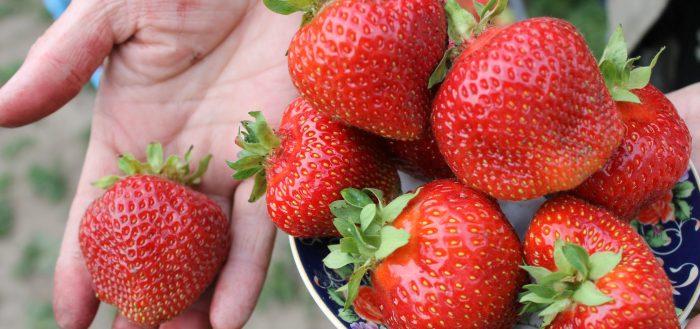

Video
This video will tell you about the Asia strawberry variety.
We examined the features of cultivating strawberries in Asia. As you can see, this variety, bred in warm Italy, is quite suitable for our climate, it may well bring good yields of delicious berries. With the help of our tips, you can more professionally approach the issue of growing strawberries on your site, and as a result of your efforts, you can get bountiful harvests of large, beautiful berries. Find out what the Symphony variety looks like from this article.
Growing history
The Asia variety appeared in the city of Cesena (Italy) in 2005. European patent 23759, patented by New Fruits. The variety is zoned for cultivation in northern Italy. It was originally planned to grow this strawberry for industrial purposes, but it is also perfect for amateur gardening.
Asia appeared on the domestic fields about 10 years ago, and quickly won the people's love.Strawberries of this variety are grown throughout Russia, and they are especially popular in the south of the country. A distinctive feature of Asia is that it can be grown with equal success both in open and closed ground, and even using a soilless method, that is, in bags.
Care
Watering, top dressing, loosening contribute to the formation of a bountiful harvest of berries.
Watering
Asia is not coping well with drought. Without regular watering, the berries become smaller, become light, hollow. For the normal development and fruiting of strawberries, watering is required from the moment of planting until the end of August. The best option is drip irrigation, but you can do it in the usual way. How much water to pour under the bush and how often depends on the weather and soil structure on the site.
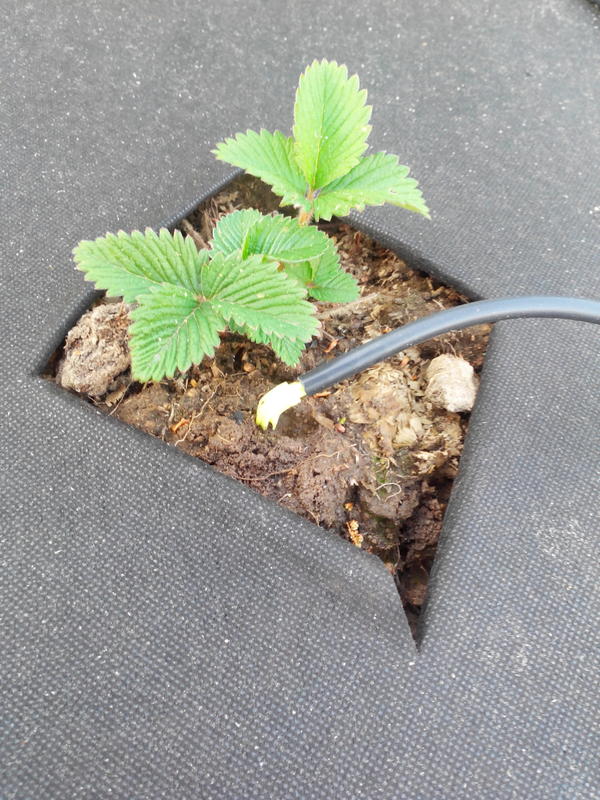

Drip irrigation is the best option for watering strawberries
Loosening
This technique can significantly increase the yield. After watering, you should wait until the water is absorbed and the earth dries slightly. Then shallowly (2 cm) loosen the plantings. This will improve soil respiration, retain water in the ground.
Mulching
Mulch is good in that it maintains a normal level of moisture, and also, if it is of organic origin, rotting, fertilizes the soil. When loosening, it can be raked to the side, and then again distributed over the area.
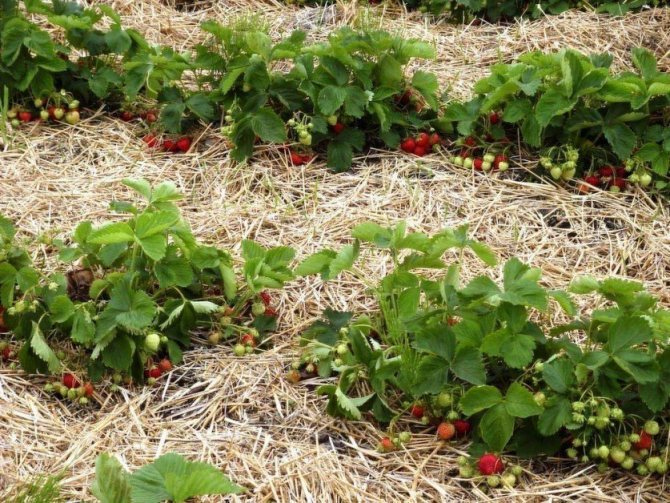

Mulch prevents soil from drying out
Fertilizers and feeding
Nitrogen, phosphorus and potassium are the three main chemical elements that strawberries especially need. There are important moments in plant life when these substances are especially important for the formation of a good harvest.
Table: the ratio of the timing and composition of dressings
| Feeding period | Mineral fertilizers | Combination of mineral and organic fertilizers | Organic fertilizers |
| April (bookmark of flower buds). |
| Mullein solution 10 l, 1 tbsp. ash, 2 tbsp. l. superphosphate. | A solution of chicken manure, mullein or herbal infusion. |
| Early May (budding period). | Potassium nitrate (2 tablespoons per 10 liters of water). | Ash solution (1 tbsp. In a bucket of water). | |
| August (laying the kidneys for next year). | Nitroammofoska root (1 tbsp. L. Per 10 l of water). |
Shelter for the winter
Asia can tolerate frost down to -15oC. In the conditions of the Russian continental climate, the plant needs shelter for the winter and protection from spring frosts. This is especially true for regions with little snowy winters.
At the end of summer, the land around the bushes needs to be loosened and mulched. Spruce branches and pine needles are used as a covering material. Hay and straw are also popular, but mice love to live under them. In spring, mulch is harvested early so that the bushes under the “roof” do not begin to grow.
Planting strawberries
The best dates for planting are May and August. The first crop in both cases will ripen next summer.
The strawberries are grown in the sunniest spot in the garden. The site must be chosen flat so that water does not stagnate. The plantings should be replaced every 3-4 years, then the berries age and the yield decreases.
Good precursors for strawberries are carrots, beets, garlic, legumes, and calendula. The place where tomatoes, potatoes, cabbage, raspberries, cucumbers, peppers grew is not suitable.
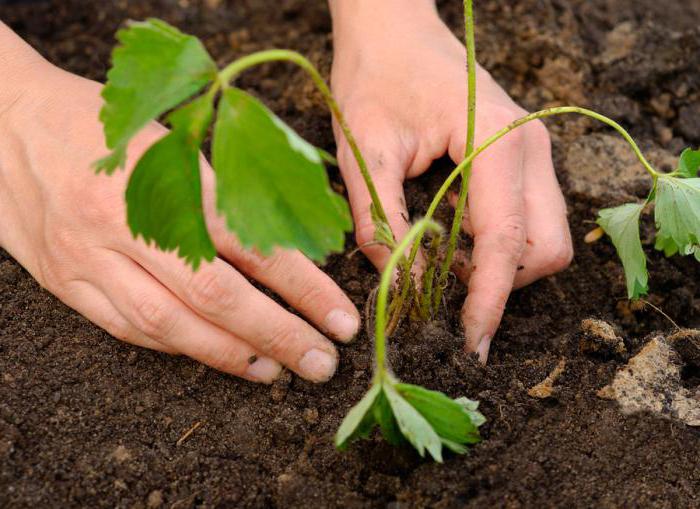

Every 3-4 years you need to change the place of the strawberry bed
Step-by-step planting process
- The plot is carefully dug up, removing weeds, and at the same time 1 bucket of humus or compost is added per 1 m2. You also need to add 5 kg of wood ash, 40 g of double superphosphate and 20 g of potassium sulfate.
- The distance between the plants in a row is 40 cm, between the rows - 60 cm, from the edge of the ridge when planting they retreat by 20 cm.
- Dig small holes, pour 0.5 buckets of water into them and carefully place the seedlings. It is better to transplant plants with a lump of earth, but if the roots are open, you need to carefully straighten them and place them vertically.
- Before planting, granular mineral fertilizers Harvest-super, Crystallin (1 tsp each) can be added to the hole and mixed with the ground.
- Gently fill in the hole, the root collar should be flush with the surface.
- Pour 0.5 buckets of water under each plant.
- When the moisture is absorbed, cover the bed with hay, straw, compost, sawdust or other plant residues.


Leave 40 cm between bushes in a row
Strawberries Asia is recommended to be grown in closed trenches. This protects the bushes from spring frosts and allows you to get the harvest much earlier. To do this, dig a trench 40 cm deep and 100 cm wide and plant the seedlings at the bottom, according to the usual planting scheme. From above, the trench is covered with a film fixed on arcs.
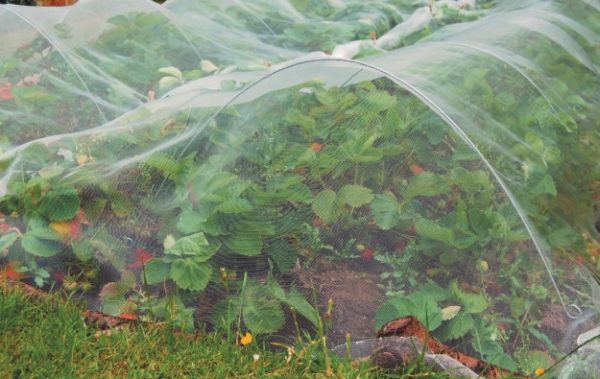

Strawberry Asia grows and bears fruit better under cover
Preventive actions
During the period when intensive growth begins, it is allowed to use means to combat diseases - white spot, brown deciduous spot, gray mold, powdery mildew.
If spots or gray molds are detected, spraying with a fungicidal agent can be applied.Topaz».
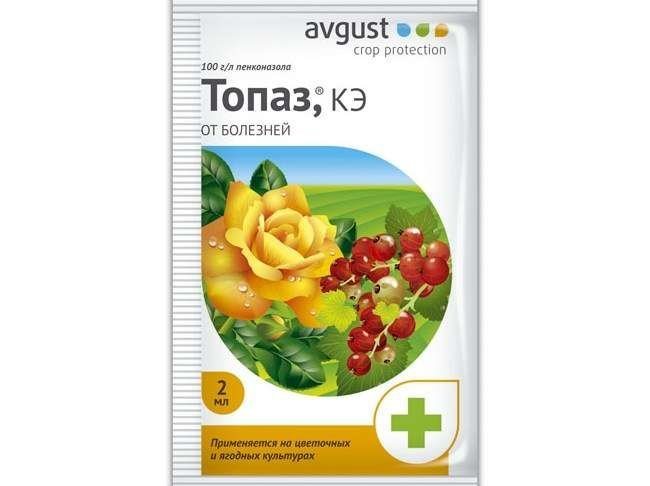

Topaz remedy copes with spotting and gray mold.
The dosage is applied on the basis of - one and a half kilograms per hectare of area... But it is also recommended to spray during harvesting, since powdery mildew can destroy about forty percent of the total productivity. Precautions must be taken to prevent the development of disease.
Irrigation
Irrigation is an important part of preventive measures... However, the measure in watering must also be respected. If there was little snow in the winter, you need to water intensively in the spring. It is also necessary to intensively irrigate during flowering, ripening and after picking berries.
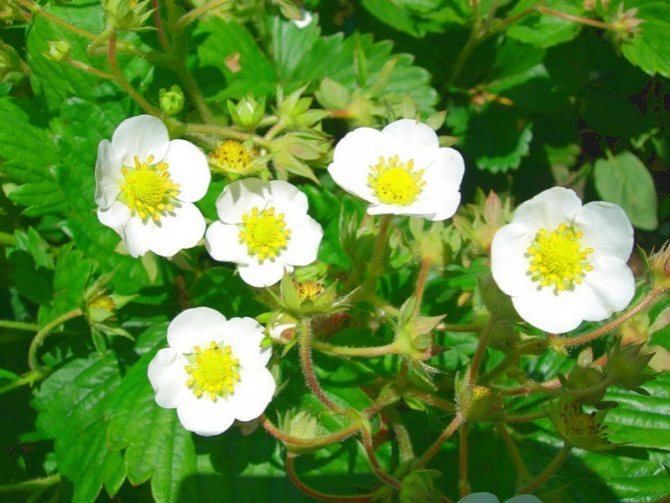

Strawberries require irrigation during the flowering period.
If spring is marked by low rainfall, watering should begin in the second half of April.... The remaining two months can be watered about three times in thirty days. August and September - twice every thirty days. Ten liters per square meter is considered the norm.
Flowering season
When the flowering season begins, the plant needs a lot of moisture.
In dry weather, water scarcity can lead to rapid infestation by pests or diseases, drying out of the root system. At this time, it is better to install constant drip irrigation so that a constant supply of water in a moderate amount is carried out. Watering is recommended in the morning.
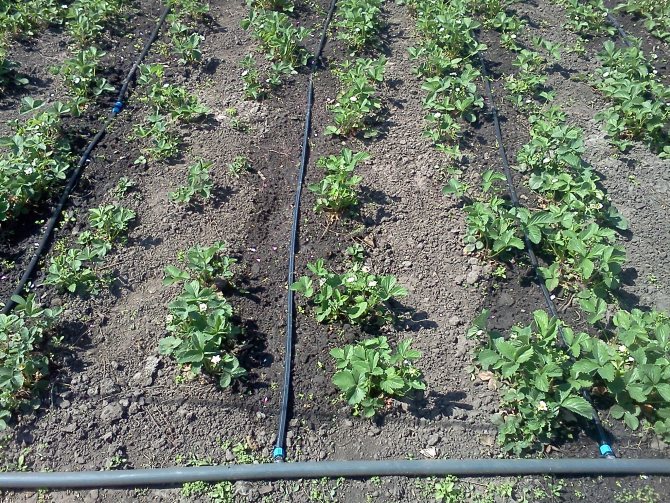

Drip irrigation will keep the soil from drying out.
Weed control
But the overgrowth of weeds is also harmful to strawberries. In addition to slowing down the growth of the bush, they are also carriers of various types of bacteria and insects. Therefore, weeding is a must. To avoid the growth of weeds, you can use mulching - straw, needles, small sawdust. And agrofibre is also used. This type of prevention also tends to retain moisture inside the roots, sufficient to feed the entire plant.
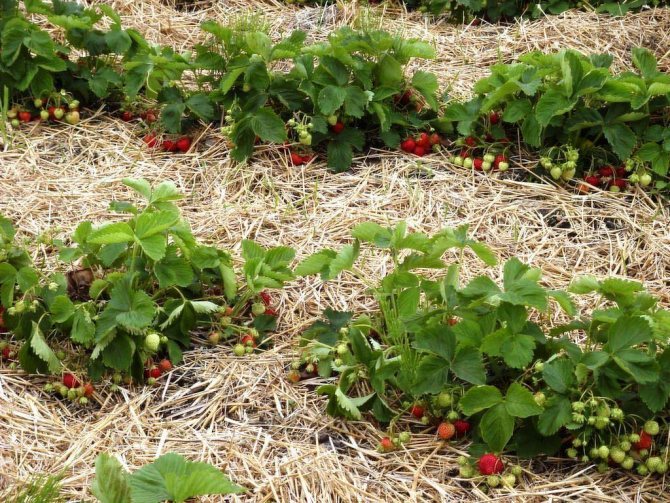

Mulching will prevent weeds from growing.
It is allowed to use drugs against weeds - "PAB", "Prism", "Select", "Fuzilad", "Lontrel 300-D", "Sinbar", "Devrinol"... It is better to use it in the summer, but it is worth carefully calculating the dose in order to prevent an overdose. If overdose occurs, the risk of burning the roots and stems of strawberries or soil increases.
Loosening the soil
Loosening the soil is the foundation of prevention. You need to loosen the ground regularly, the best time is after rain or with freshly emerged weed shoots.
So that the roots are not exposed, they need to be constantly hilled. It is recommended to loosen and huddle the culture at least seven times during the growing season.
The first time weeding and hilling is done in the spring.
- The procedure is carried out between the rows of plantings and around the roots.
- Before the procedure, ammonium nitrate is scattered at the rate of one hundred twenty grams per ten running meters of a row.The tool is a wide hoe or a bayonet shovel.
- With the help of a hoe, they deepen to a distance of ten centimeters, with a shovel between rows - by seven centimeters, around the root - by four centimeters.
- On the other side of the row, a longitudinal hole is made for backfill superphosphate and potassium sulfate... In this case, superphosphate - one hundred and fifty grams, potassium sulfate - eighty grams, which are mixed with one kilogram of dry humus. The hole is filled up and tamped.
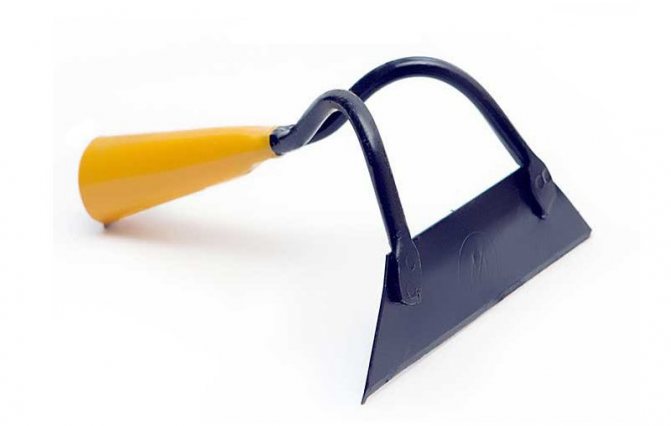

It is advisable to loosen the soil with a wide hoe.
Features of agricultural technology
The yield indicators declared by the manufacturer are possible only with full adherence to agrotechnical methods. This variety can be called somewhat capricious, requiring care and attention, but according to the experience of gardeners, all this pays off with generous harvests.
Landing
Garden strawberries "Asia" are planted like any other varieties, either in the spring (April or May) or in the fall (in September). They take into account the climate of the region, the possibilities of leaving. When planting in spring, there is a rapid survival rate of the bushes, but the berries will only be in the next season.
On a note! In summer, the planted bushes need to cut off the mustache, peduncles to strengthen the roots and rosettes.
When planted in autumn, the first harvest will appear the next summer, but there is a risk of freezing out the planted bushes of culture in winter.
Seedlings should be strong, healthy, with a horn thickness of about 1 cm and 2-3 leaves. The purchased bushes must be disinfected in a solution of copper sulfate (the roots are lowered for 8-10 minutes), it is also good to soak them in growth stimulants.
Particular attention is paid to the choice of beds for "Asia", with fertile loose soil, in well-lit areas. Exclude lowlands, acidified soils, loam and clay. They bring in a bucket of humus per 1 sq. meter, potash and phosphorus compositions - 15-20 grams per 1 sq. meter.
They are planted in holes, according to any scheme (in rows, in a checkerboard pattern), based on the width of the beds and the convenience of crop care. Leave a distance between the holes of at least 40 cm, since the plants are powerful, with a voluminous ground part.
Care
Further techniques are traditional: watering, fertilizing, loosening row spacings, weeding. Water it every 2-4 days, depending on the weather and the condition of the plants. Up to 2-3 liters of water is poured under an adult bush. This variety does not like prolonged drought, and in order not to get a void in the berry pulp, it is advisable to ensure regular irrigation.
In the first season, young bushes do not need feeding, so they are carried out only when necessary. Then they act according to the scheme:
- before flowering - formulations with a high nitrogen content;
- at the beginning of flowering, potash and phosphorus compounds are introduced, sprayed on the sheet with ready-made compositions for the culture ("Ovary", "Agricola");
- after picking berries, complex fertilizers (nitrophoska) are applied to the ridges;
- before wintering, fertilize with superphosphate.
They take care of them carefully, strictly control the rates of fertilizing, especially nitrogen compounds.
Reproduction
Garden strawberries are propagated in various ways, and Asia is no exception. But if propagating by seeds is troublesome and too laborious, then planting with rosettes or reproduction by dividing a bush is available and easy to do even for novice gardeners.
There are not many mustaches in this variety, so you should be patient. First, they select the outlet closest to the bush, fix it to the surface of the earth for rooting. It remains to wait until, by the end of summer, the future bush will give roots and then, having separated it from the mother bush, transplanted to a new place.
On a note! It is recommended to plant young sockets on a specially prepared garden bed, and in the spring to determine it in a permanent place.
To divide the bush, you will need to choose strong, healthy plants (2-3 years old), without spots and leaf deformations. Action steps:
- dig up a bush;
- divide the roots and the plant into 2-3 parts, so that each delenka has healthy roots and a horn;
- the separated bushes are planted in a permanent place.
They purchase planting material from agricultural firms that offer the variety with frigo seedlings.
Planting and breeding
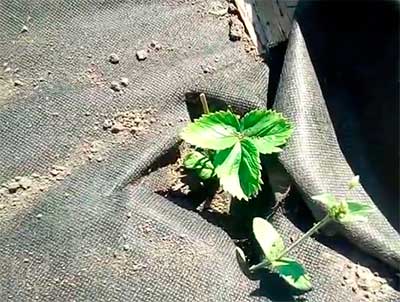

Strawberry "Asia" prefers to grow on fertile sandy loam or loamy soilcharacterized by lightness and good breathability. But it can be placed on other types of soil, if before that you add a special composition of 0.5 buckets of coarse river sand, 2 buckets of rotted manure, a tablespoon of wood ash and 50 grams of urea to it. It is better to do this 2 weeks before the estimated date of disembarkation.
When placed outdoors, the size of the bushes and the photophilousness of the strawberries should be taken into account. It is usually large, and therefore the distance between plants must be at least 40 cm. At the same time, it is desirable that the bushes are well illuminated by the sun from all sides.
Important! It is impossible to plant "Asia" in the lowlands because its roots will begin to rot from stagnant water. On hills and hillocks, it may lack moisture.
In the first year after planting, it is very important to cut off all mustache and existing flower stalks from strawberries. This will allow her to form a strong root system, increase her frost resistance and begin to bear fruit well. In any case, she will begin to bring berries only next year.
There are three ways to multiply “Asia”.
Seeds
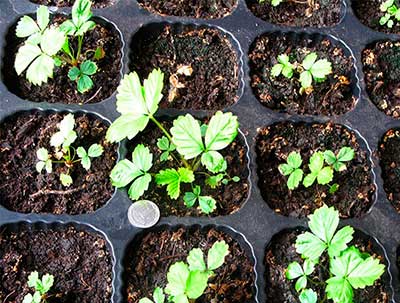

This is the most troublesome method. To carry it out, it is necessary to lay the seeds on the very edge of the toilet paper, roll them up and place them in water so that the liquid does not reach the planting material. Next, you need to cover the whole thing with a bag and leave for 2-3 days for seeds to germinate. Then plant the plants in the ground. The harvest in this case can be obtained only after a few years.
Mustache
The first rooted outlet is carefully cut from the mother bush and transplanted to a new location. The rest are simply deleted. It is worth noting that you can take antennae only from a two- or three-year-old plant.
Dividing the rhizome
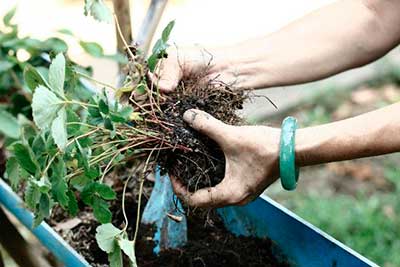

After the end of fruiting, the bushes are dug up and carefully divided into 2-3 parts. This is usually done in cloudy weather. The best breeding option is the second. Since with the correct transplantation of young rosettes to a new place, they will delight you with a rich harvest next year.
Reproduction
Strawberry variety Asia is able to reproduce by stepchildren, dividing the bush and seeds. The last method is the most difficult.
Stepchildren
The most common way to breed strawberries is with a mustache:
- In bushes that are two years old, peduncles should be cut off so that all the nutrients go to the stepsons.
- The mustache is pressed to the ground and secured with staples.
- Only one outlet is left on the shoot.
- Already in July, the rosettes will take root, and the shoots are cut off from the bush.
- In early autumn, the bush can be transplanted to a new location.
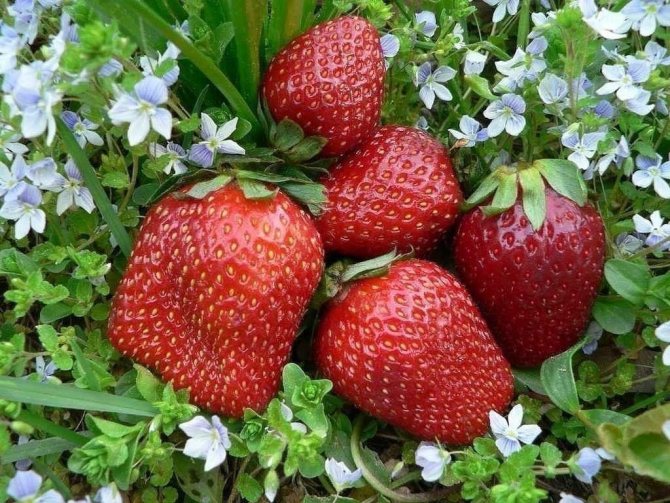

Since the mustache of the Asia variety is formed little, it is better to use the breeding method by dividing the bush.
Seeds
The most difficult thing is propagation by seeds. Landing requires compliance with some rules:
- 3.5 months before planting, the seeds are moved to a cool place at a temperature of +2 degrees;
- before sowing, the seeds must be thoroughly dried;
- in January, they start sowing seeds for seedlings;
- the container is placed on a well-lit windowsill;
- the room temperature should be at least +20 degrees;
- seedlings are transplanted into open beds at the end of May.
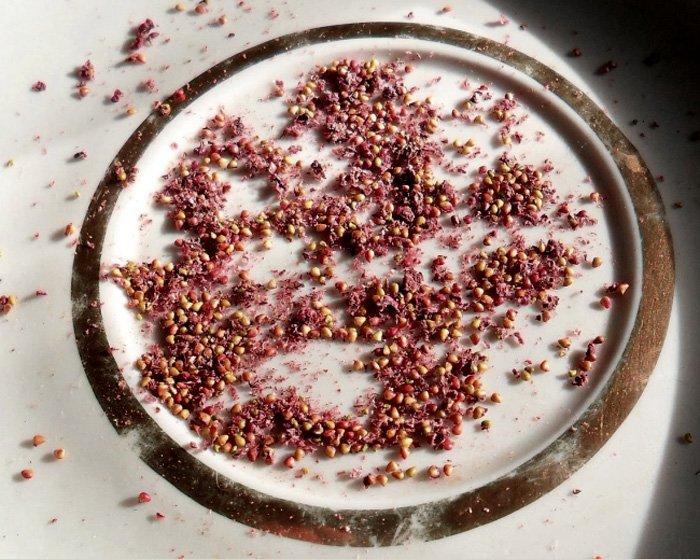

Dividing the bush
For reproduction, they take a bush that is three years old. Divide it into several parts. Each separated bush should have healthy root branches and a few leaves. Prepared seedlings are planted in the garden in early September.
The right and wrong neighborhood of cultures
When choosing a plot for garden strawberries, as well as planting vegetables, shrubs, flowers, take into account their compatibility with berries. Distinguish cultures:
- Favorable. Garden strawberries get along well with beans, spinach, parsley, garlic, lettuce, onions, radishes, radishes, beets, as well as herbs - sage and cucumber grass.
- Unfavorable. You cannot plant all the vegetables of the family of nightshades and cloves, raspberries, sunflowers, Jerusalem artichoke and horseradish nearby with strawberries.
It is useful to plant parsley between strawberry beds - it repels slugs well.
Advantages and disadvantages
Strawberries Asia is worth growing because of its large size, due to the fact that it ripens quite early - it blooms in May, you can harvest in June. It is suitable for growing in open beds and indoor greenhouses, as well as in hydroponics. The variety is resistant to various spots, verticillium, rot, tolerates weather changes well, and is adapted to various weather conditions.
Disadvantages: affected by anthracnose and powdery mildew, sometimes chlorosis, quite picky about soil, moisture and nutrition. Seedlings of the variety are not sold in grocery stores, they can be purchased from hobbyists or online stores.
History of the variety "Asia"
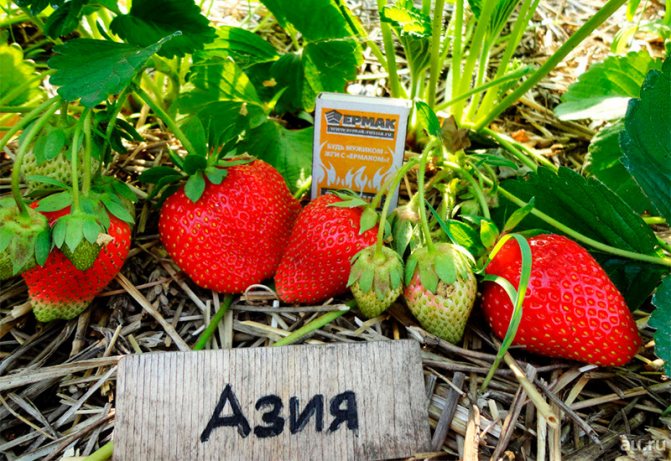

Judging by the gardeners' reviews, "Asia" is grown everywhere, from the southern regions of the country to the Northwest, Siberia, and the Far East. The originator of the variety is New Fruits SAS (Italy), whose breeders are engaged in the development of new varieties of garden strawberries, fruit crops, as well as truffles, asparagus.
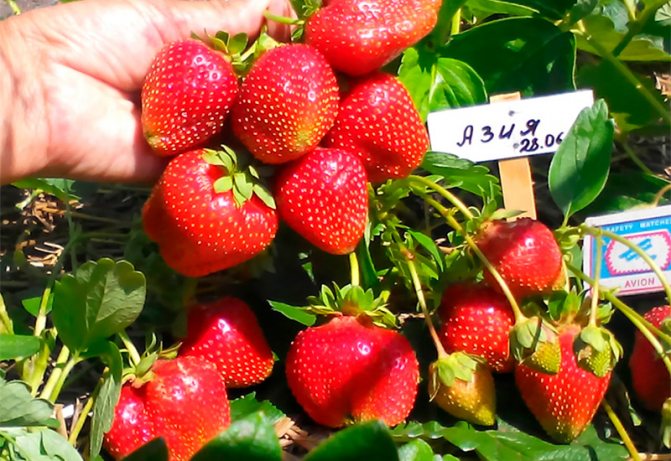

In the early 2000s, several varieties of large-fruited strawberries were introduced to the market, positioned by the manufacturer as adapted for zones with a temperate climate. These are "Alba", "Syria", "Roxana", as well as "Asia" (Asia NF 421), which very quickly gained popularity in European countries, in Russia, in a number of CIS countries.
Garden strawberry "Asia" is included in the registers of approved varieties in Europe, Ukraine, Belarus, until it is registered in the State Register of the Russian Federation. In specialized stores, planting material is not sold; they usually purchase seedlings from breeders, amateurs, as well as through online stores of agricultural firms.

